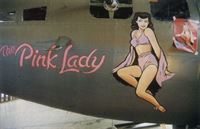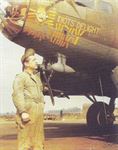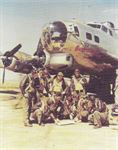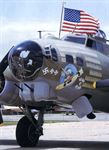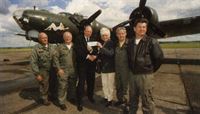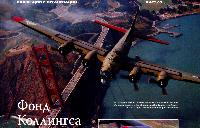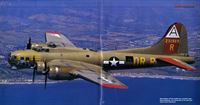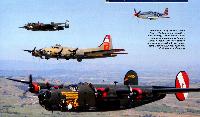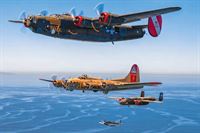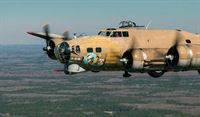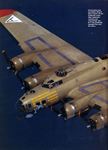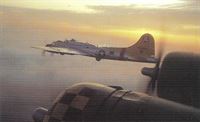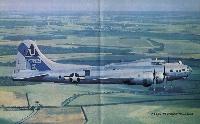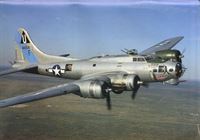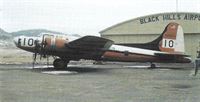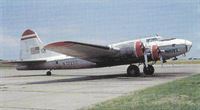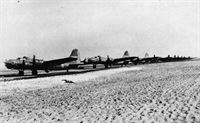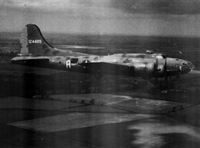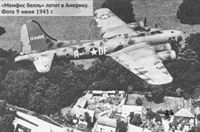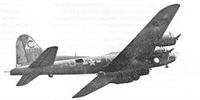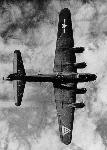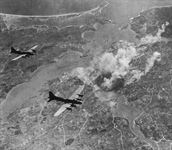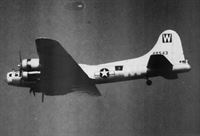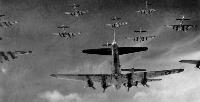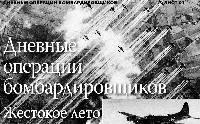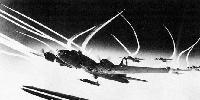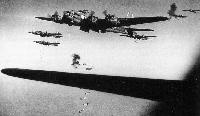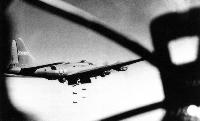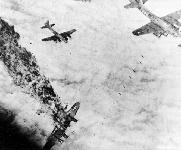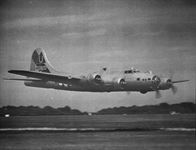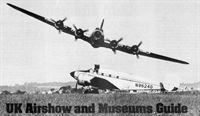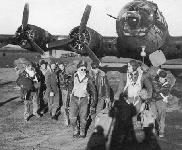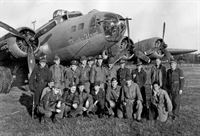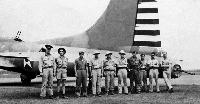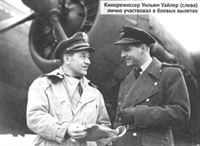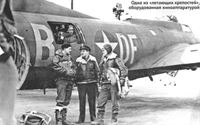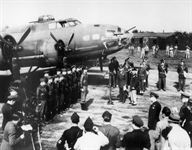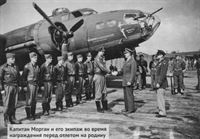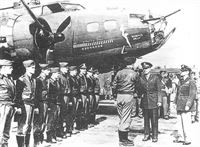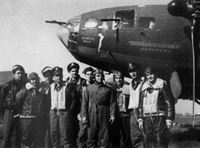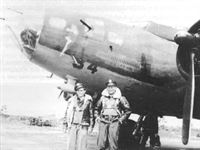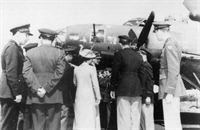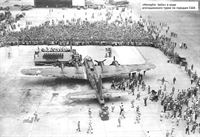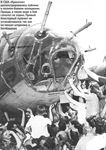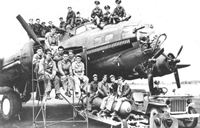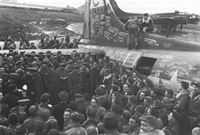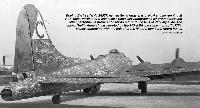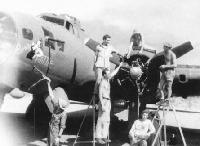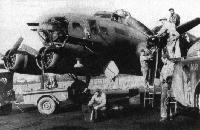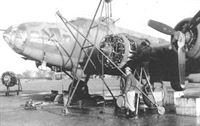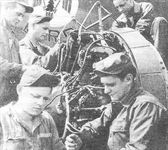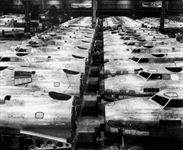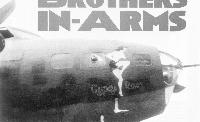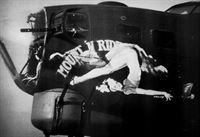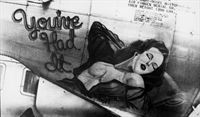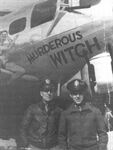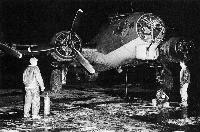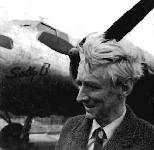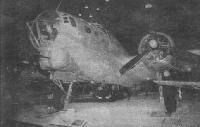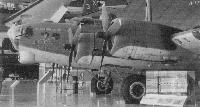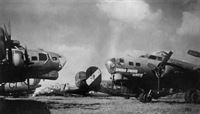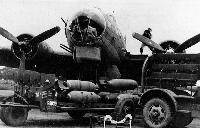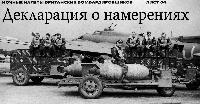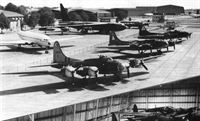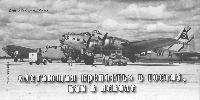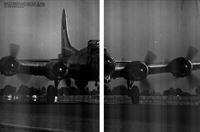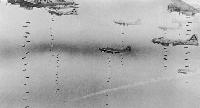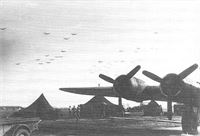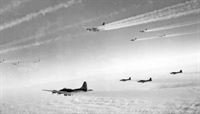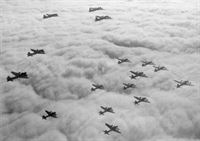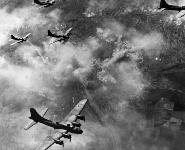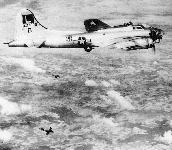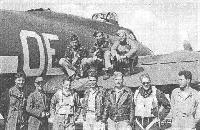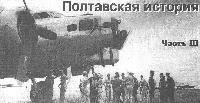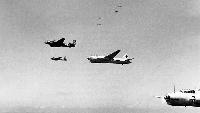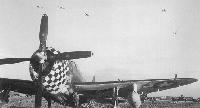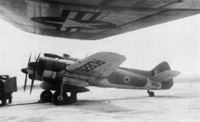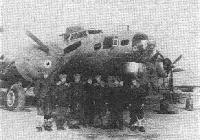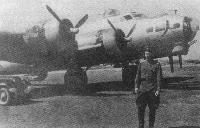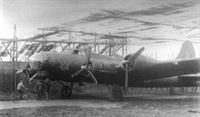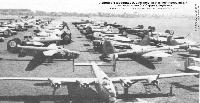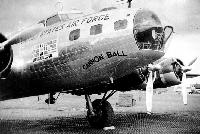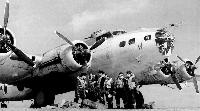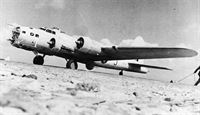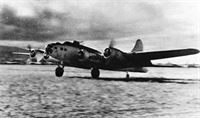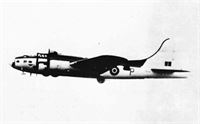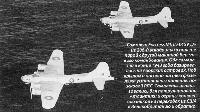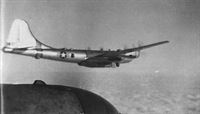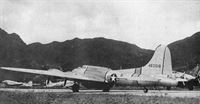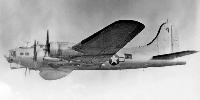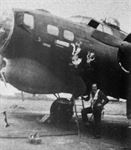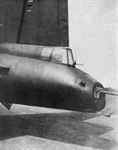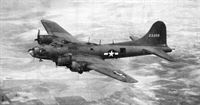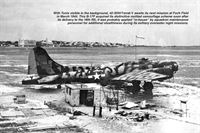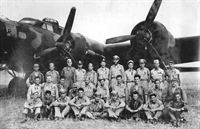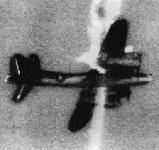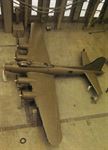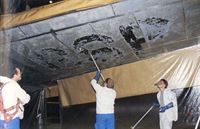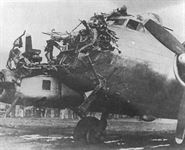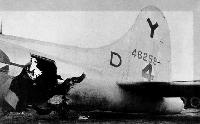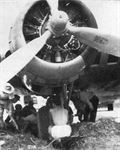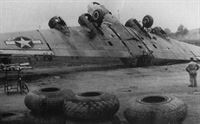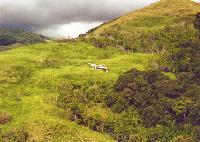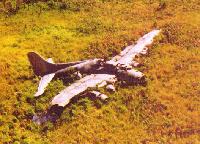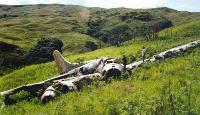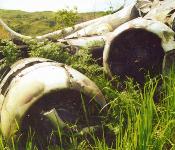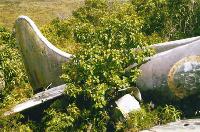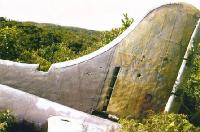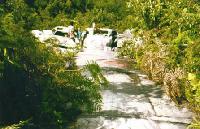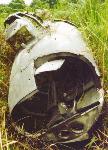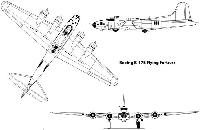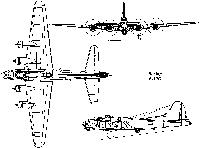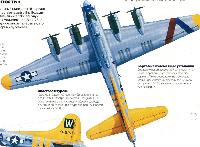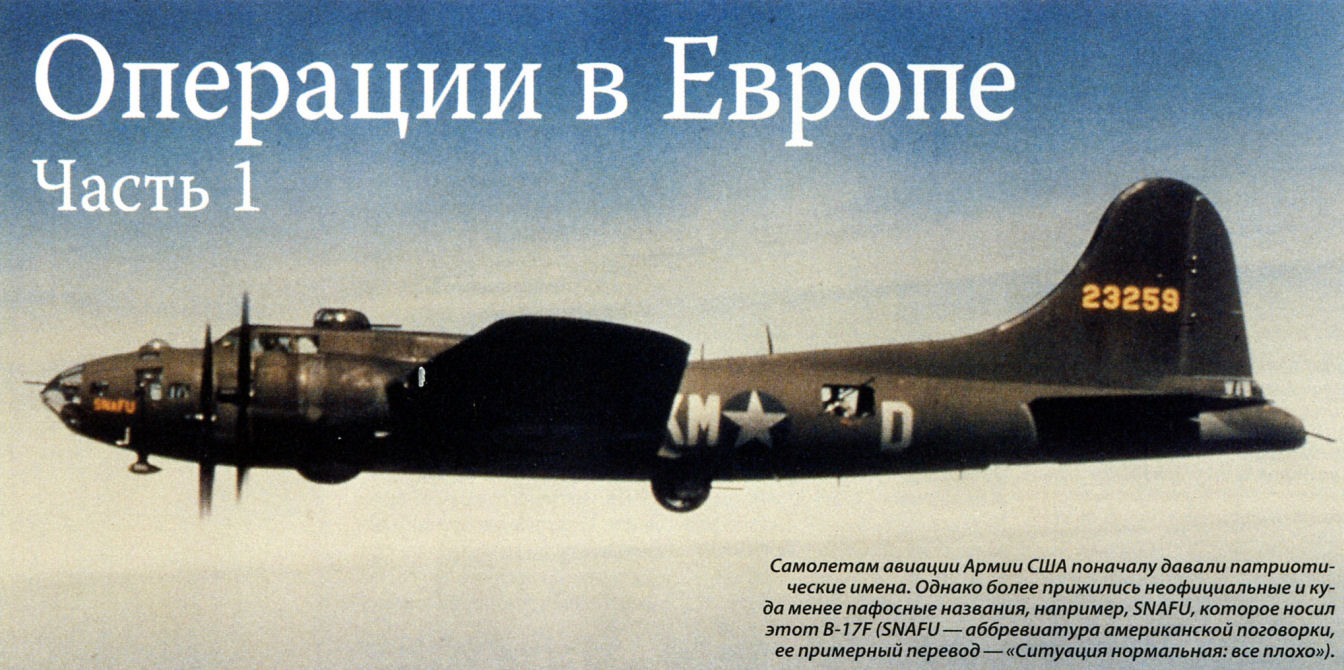
Варианты
- Boeing - B-17 Flying Fortress - 1935 - США
- Boeing - B-17E / B-17G Flying Fortress - 1941 - США
- Boeing - C-108 / VB-17G - 1943 - США
B-17E / B-17G Flying Fortress
Тяжелый бомбардировщик, четырехмоторный цельнометаллический моноплан с убирающимся шасси с хвостовым колесом. Экипаж 6-10 человек. Спроектирован в КБ фирмы "Боинг эйрплейн" под руководством Э.Эмери и Э.Уэллса. Опытный бомбардировщик "модель 229" впервые взлетел 28 июня 1935 г. Серийное производство начато в декабре 1936 г.
Выпускался на заводах "Боинг" в Сиэттле, "Вега эйркрафт корпорейшн" в Бэрбанке, "Дуглас" в Лонг-Бич. Всего построен 12 731 экз. B-17 состоял на вооружении в США с марта 1937 г., в Великобритании - с марта 1941 г., в СССР - с апреля 1945 г.
Основные серийные модификации:
- B-17C ("Фортресс" I) с моторами R-1820-65, вооружение 5x12,67+1x7,62, бомбы до 1235 кг;
- B-17D с протектированными бензобаками, дополнительной бронезащитой, вооружение 7x12,7+1x7,62, бомбы до 1235 кг;
- B-17E с новыми хвостовой частью фюзеляжа и оперением, вооружение 8x12,7+ 1x7,62, бомбы до 8000 кг, на поздних сериях - шаровая подфюзеляжная турель;
- B-17F ("Фортресс" II) с новой носовой частью фюзеляжа, противопыльными фильтрами, протектированными маслобаками, дополнительными бензобаками, моторами R-1820-97, вооружение 8x12,7+1x7,62 или 11x12,7 (с F-75), бомбы до 9500 кг, отдельные самолеты оснащались РЛС H2S;
- B-17G ("Фортресс" III) с измененной схемой вооружения, вооружение 11-13x12,7, с G-50 разнесенные по длине бортовые стрелковые установки, на отдельных самолетах РЛС Н2К.
Первый случай боевого применения - налет английской авиации на Вильгельмсхафен в июле 1941 г. Английские "крепости" небольшими группами совершали налеты на Гамбург, Эмден, Дюссельдорф, Осло, Брест. С октября 1941 г. английские самолеты использовались в Европе только в Береговом командовании как патрульно-противолодочные. В Африке они действовали до мая 1942 г., совершая налеты на Тобрук и Бенгази.
Американские B-17 получили боевое крещение в декабре 1941 г. на Гавайях и Филиппинах. В январе 1942 г. участвовали в боях на о.Ява, активно применялись затем на море (в т.ч. в сражениях в Коралловом море и у Мидуэя). С февраля 1942 г. дислоцировались также в Индии. С 1943 г. убраны с Тихоокеанского театра, где заменены на B-24, зато с августа 1942 г. применялись в Европе (с баз в Великобритании). С января 1943 г. совершали массированные дневные налеты на цели в Германии. С начала 1944 г. - основной тип американского бомбардировщика на европейском театре. Применялся также как дальний разведчик, самолет РЭП и спасательной службы, военно-транспортный. В июне - сентябре 1944 г. B-17 участвовали в "челночных" операциях с баз на Украине. "Крепости" ВВС армии США использовались на фронте до конца войны в Европе. Советские B-17 в боевых действиях не участвовали.
B-17 сняли с производства в июле 1945 г. Большая часть была снята с вооружения в 1946 г., но отдельные машины эксплуатировались ВВС США до 1956 г., а в Береговой охране они служили до 1959 г.
B-17G||
Размах:||31,63 м
Длина:||22,65 м
Моторы, количество х мощность:||4x1200 л.с.
Взлетная масса, максимальная:||30000 кг
Максимальная скорость:||460 км/ч
Практический потолок:||10900 м
Дальность:||5400 км
Описание:
- B-17E / B-17G Flying Fortress
- F-9
- Boeing Model 299 (B-17 Flying Fortress, B-40, BQ-7 и другие)
Фотографии
-
Мировая Авиация 249
B-17E стал в 1942 году основным американским бомбардировщиком на Тихом океане. Этот «Tojo's Jinx» был среди тех B-17E, которые в начале 1942 года прибыли в Австралию для пополнения эскадрилий, потрепанных в боях за Филиппины и Яву. Самолет, оснащенный шаровой турелью «Sperry» (появилась на B-17E второй производственной серии взамен дистанционно-управляемой турели «Bendix»), был придан 19-й бомбардировочной группе - красный руль направления был характерен для самолетов этого подразделения.
-
Мировая Авиация 61
B-17F "Летающая крепость". Этот Boeing B-17F-40-BO (42-5177) из 303-й бомбардировочной группы летом 1943 года участвовал в операциях, в которых действовало до 300 самолетов. На самолете изображена эмблема, типичная для периода с июля 1942 по июль 1943 года.
-
Air Enthusiast 1995-09 / P.Porter - Hub of the first USAAF
Boeing B-17F Flying Fortress 25846 ‘MS-X’ Tinker Toy of the 535th BS, 381st BG, Ridgewell.
-
Air Enthusiast 1995-09 / P.Porter - Hub of the first USAAF
Boeing B-17F Flying Fortress 25763 ‘LL-F’ Bomb-Boogie of the 401st BS, 91st BG, Bassingbourn.
-
Авиация и Космонавтика 2015-07 / Знаменательные даты июля в истории авиации
Бомбардировщик Боинг B-17F
-
Авиация и Время 1996-06 / Д.Кальной, А.Совенко - Полтавская история /Аэроархив/ (1)
B17-G-30DL из 418-го BS 100-й BG 8-й воздушной армии - участник операции Frantic-2
-
Авиация и Время 1996-06 / Д.Кальной, А.Совенко - Полтавская история /Аэроархив/ (1)
B17-G-35BO из 346-го BS 99-й BG 15-й воздушной армии - участник операции Frantic-1
-
Авиация и Космонавтика 2016-08 / В.Бакурский - Звезды на крыльях
Характерный пример раскраски американских «летающих крепостей» в конце войны
-
Мир Авиации 1995-02 / В.Раткин - B-17 и B-24 в составе АДД /В строю советских ВВС/
B-17G-40-VE N 42-97996 из 890 авиационного Брянского полка 45 ТБАД. Найден в н.п. Рудники на аэродроме 16-й ВА. 8 мая 1945г. самолет перегнали на аэродром 45 ТБАД в Барановичах. Экипаж: И.А.Щадных (командир), Н.Балдов (второй пилот), В.Семенов (штурман), Тишков (2-й штурман), Н.И.Ковалев (борттехник), П.Трофимец (техник самолета), Щербаков (механик самолета).
-
Мир Авиации 1995-02 / В.Раткин - B-17 и B-24 в составе АДД /В строю советских ВВС/
B-17G-50-DL N 44-6316 поступил в 45 ТБАД 11 июля 1945г. Окраска соответствует времени, когда самолет нашли и первым делом нанесли красные звезды по бортам фюзеляжа (на крыле еще сохранились американские опознавательные знаки). Оставшаяся американская маркировка говорит о том, что машина принадлежала 358 бомбардировочной эскадрилье (на борту - индекс VK) 303 бомбардировочной группы (на киле - буква C в треугольнике). Весьма вероятно, что на носу самолета имелось какое-либо изображение и/или надпись.
-
Авиация и Космонавтика 2019-06 / С.Йоканович - Летающие крепости с аэродрома Сомбор
B-17G серийный номер 44-6422.
-
Мировая Авиация 26
B-17G "Летающая крепость". "Short Arm" представляет собой окончательный стандартный вариант "Летающей крепости" последних серий, поставляемый в 8-ю Воздушную армию США в конце 1944 года и воплотивший в себе все улучшения и доработки, взятые с более ранних модификаций. B-17G был одним из наиболее защищенных бомбардировщиков тех времен, его вооружение состояло из 13 крупнокалиберных пулеметов.
-
Авиация и Космонавтика 2015-07 / Знаменательные даты июля в истории авиации
Бомбардировщик Боинг B-17G
-
Мировая Авиация 53
Регистрационный номер: KH998 Fortress B.Mk III(SD). 100-я группа спецназначения была сформирована в ноябре 1943 года для координации в масштабах всего Бомбардировочного командования усилий по радиотехническому и "силовому" подавлению системы ПВО противника. Ранее задачи постановки помех выполнял ряд мелких разбросанных подразделений. Здесь изображен самолет 214-й эскадрильи специального назначения, базировавшейся в Оултоне.
-
Авиация и Время 2002-01 / М.Жирохов, Д.Шевчук - ВВС Израиля, 1948-49гг. (3)
B-17G из 69-й эскадрильи составляли главную ударную силу ВВС Израиля
-
Мировая Авиация 26
Самолетам авиации Армии США поначалу давали патриотические имена. Однако более прижились неофициальные и куда менее пафосные названия, например, SNAFU, которое носил этот B-17F (SNAFU - аббревиатура американской поговорки,
ее примерный перевод - "Ситуация нормальная: все плохо"). -
Мировая Авиация 183
Прототип Boeing B-17 Flying Fortress выполнил первый полет в 1935 году. С точки зрения ряда историков авиации, B-17 остается в тени не менее удачного, но более массового B-24. B-17 стал основным самолетом, выполнявшим дневные налеты на Третий рейх.
-
Мировая Авиация 26
Ясная погода способствовала точности бомбометания, но и делала самолеты хорошими целями для вражеских зенитчиков. Эти B-17F готовы сбросить бомбы по сигналу командира группы.
-
Aeroplane Monthly 1989-09
The stars of the forthcoming film Memphis Belle, the aerial sequences of which were being filmed in the UK during June, July and August 1989.
-
Авиация и Космонавтика 2019-07 / В.Блинов - "Красотка из Мемфиса". История бомбардировщика B-17 "Memphis Belle"
B-17 «Мемфис белль» в национальном музее ВВС США
-
Авиация и Космонавтика 2019-07 / В.Блинов - "Красотка из Мемфиса". История бомбардировщика B-17 "Memphis Belle"
Редкий снимок «Мемфис белль», сделанный зимой - весной 1943 года. На борту еще очень мало отметок о боевых вылетах. Виден ранний тип рисунка на колпаках колес шасси. В носовом блистере нет пулеметов, а с внутренней стороны нет креплений для них.
-
Авиация и Космонавтика 2019-07 / В.Блинов - "Красотка из Мемфиса". История бомбардировщика B-17 "Memphis Belle"
«Мемфисская красотка» после 25-го вылета. На колпаках шасси поздний тип рисунка. На левом колесе голубой фон и красные звезды
-
Авиация и Космонавтика 2019-07 / В.Блинов - "Красотка из Мемфиса". История бомбардировщика B-17 "Memphis Belle"
Командир экипажа капитан Морган. Видна верхняя турель бортинженера. Светло-зеленое пятно под открытой форточкой - заплатка, которой заделали пробоину и закрасили краской другого оттенка
-
Авиация и Космонавтика 2019-07 / В.Блинов - "Красотка из Мемфиса". История бомбардировщика B-17 "Memphis Belle"
Техник самолета рисует очередную бомбочку на борту. Эти кадры возвращения "Красотки" из 25-го вылета были постановочными, так как техник рисует 26-ю бомбочку (у "Мемфис белль" над 25-й бомбочкой была красная звездочка, над 23-й и 24-й - желтые звездочки). Затем эту 26-ю бомбочку стерли, и на поздних фотографиях видны лишь ее следы.
-
Авиация и Космонавтика 2019-07 / В.Блинов - "Красотка из Мемфиса". История бомбардировщика B-17 "Memphis Belle"
После выполнения последнего 25-го вылета капитан Морган хлопает по изображению девушки
-
Авиация и Космонавтика 2019-07 / В.Блинов - "Красотка из Мемфиса". История бомбардировщика B-17 "Memphis Belle"
Нос фюзеляжа "Мемфис белль" в конце боевой карьеры. За остеклением блистера видны крепления для пулеметов
-
Авиация и Космонавтика 2019-07 / В.Блинов - "Красотка из Мемфиса". История бомбардировщика B-17 "Memphis Belle"
«Мемфис белль» в процессе восстановления. Реставраторы постарались сохранить исходные надписи и рисунки
-
Aeroplane Monthly 1998-10 / X.Meal - Repainting the Pink Lady
Регистрационный номер: F-AZDX [14], F-BGSP [14] The completed Pink Lady nose art, painted freehand by Gilles Conte. Taped alongside is the 1940s Vargas pin-up which inspired it.
-
Aviation Historian 32
Регистрационный номер: G-BEDF [31], N17TE [31] Brian Turpin has added interest to the correction by kindly sending us the picture. He says, “Attached is a photo of David (left), Clive Denney and myself at Binbrook on August 6, 1989, just prior to leaving for Prestwick en route to Buffalo. We are standing under the nose of Boeing B-17 Flying Fortress Memphis Belle. Behind is Sally B pretending to be the Belle. Clive was on the trip as flight engineer and relief pilot”.
-
Aeroplane Monthly 1998-10 / X.Meal - Repainting the Pink Lady
Регистрационный номер: F-AZDX [14], F-BGSP [14] Rollout. Resplendent in its new 351st Bomb Group colours, 44-8846 lacks only its nose art.
-
Aeroplane Monthly 1997-03 / M.Oakey - Vintage news
Boeing B-17F Flying Fortress 42-29782, seen here in Boeing’s 737/757 assembly hall at Renton, is being rebuilt to zero-hour standard for the Seattle Museum of Flight by a team of 80 volunteers. Rollout is scheduled for early February 1997, with first flight in May.
-
Air Enthusiast 1998-11 / K.Wixey - Boeing's Battle Wagon
Master Sergeant Penrose Bingham under the nose of B-17F ‘Idiot’s Delight’. There are 50 mission tallies and at least 14 fighter ‘kills’ marked up.
-
Air Enthusiast 1998-11 / K.Wixey - Boeing's Battle Wagon
Another posed crew-ready-and-willing shot. The backdrop is B-17G-70-BO 43-37704 of the 381st BG, 535th BS, Ridgewell. Issued to Ridgewell in June 1994, it was abandoned near Caen, France, on August 8 that year.
-
Aeroplane Monthly 2000-02 / M.O'Leary - The B-17 that would not die /Warbird air-to-air/
Регистрационный номер: N93012 [15] With Stars and Stripes flapping in the breeze, the bomber shows off its distinctive nose art.
-
Мировая Авиация 106
Регистрационный номер: G-BEDF [31], N17TE [31] B-17 "Sally B" - единственный сохранившийся в Великобритании самолет этого типа, хотя британцев с этими машинами связывает очень многое. "Sally B"- это B-17G (хотя в своей долгой карьере он был также EB-17G и TB-17G), а в Великобритании он летает с 1975 года, благодаря энтузиазму отдельных лиц, включая и саму Элли Солингбоу, в чью честь этот самолет и был назван.
-
Aeroplane Monthly 1998-12 / M.Oakey, T.Harmsworth - News
Регистрационный номер: G-BEDF [31], N17TE [31] On the Channel Island of Guernsey, work to replace the port inner engine on Boeing B-17G Flying Fortress G-BEDF Sally B is progressing. On Saturday October 10, 1998, the offending engine had its oil drained, and the fuel lines and control links were all disconnected. The following Saturday saw the removal of the engine, the crew from the mainland being assisted by personnel from Aircraft Servicing of Guernsey Ltd. The bomber has been on the ground since September 16.
-
Aeroplane Monthly 2000-08 / News
Регистрационный номер: G-BEDF [31], N17TE [31] Ted Inman hands the cheque to Elly Sallingboe.
-
Aeroplane Monthly 2000-04 / 2000 Airshows & Museums Guide
Регистрационный номер: G-BEDF [31], N17TE [31] With a bootful of left rudder from the captain to keep her straight, B-17 Sally B gathers speed for take-off.
-
Aeroplane Monthly 1999-05 / 1999 UK Airshows & Museums Guide
Регистрационный номер: G-BEDF [31], N17TE [31] Sally B thunders low across the airfields of Britain in tribute to the contribution to the Allied war effort made by Boeing’s most famous bomber, the B-17 Flying Fortress.
-
Aeroplane Monthly 1999-05 / 1999 UK Airshows & Museums Guide
Регистрационный номер: G-BEDF [31], N17TE [31] Capturing all the drama and nostalgia of wartime aviation, the B-17 has attracted a global supporters’ club on which the owners depend to keep this venerable old warbird in the air.
-
Авиация и Космонавтика 2015-07 / Знаменательные даты июля в истории авиации
Регистрационный номер: G-BEDF [31], N17TE [31] -
Aeroplane Monthly 2000-04 / 2000 Airshows & Museums Guide
Регистрационный номер: G-BEDF [31], N17TE [31] Old stager: Boeing B-17G Sally B will celebrate 25 years as a display aeroplane during the 2000 season.
-
Мировая Авиация 26
На B-17G удалось решить проблему установки мощного оборонительного вооружения в носовой части фюзеляжа. Эта модификация была оснащена четырьмя 12,7-мм пулеметами в двух установках (в носовой и верхней части, каждая с двумя пулеметами), а также двумя фюзеляжными установками 12,7-мм пулеметов с ручным управлением.
-
Aviation Historian 32
Регистрационный номер: N17TE [31], G-BEDF [31] TAH subscriber Mike Provost sent us these photographs, which he took at Duxford in April 1975. They show newly arrived B-17 Sally B, still bearing the legend “Euroworld” on its nose (it was actually the name of the ferrying company established by B-17 Preservation Ltd’s founder Ted White). David Tallichet’s B-24 Delectable Doris is visible in the background of both images.
Другие самолёты на фотографии: Consolidated B-24H / B-24J Liberator - США - 1943
-
Air Enthusiast 1998-11 / K.Wixey - Boeing's Battle Wagon
Регистрационный номер: N900RW Bomb doors open, B-17G-105-VE 44-85718 (N900RW) ‘Thunderbird’ taxying at Oshkosh. This late-built machine joined the French civilian geophysical survey organisation IGN in mid-1948 and was retired in the late 1970s, going into the ‘warbird’ world in 1984.
-
Air Enthusiast 1998-11 / K.Wixey - Boeing's Battle Wagon
Регистрационный номер: N7227C [2] A familiar US airshow performer, vividly exhibiting a rewarding use for that abundant nose Plexiglas! ‘Texas Raiders’, B-17G-95-DL 44-83872 (N7227C) of the Confederate Air Force.
-
Aeroplane Monthly 1986-03 / Photographic Competition: The Winners
Регистрационный номер: G-BEDF [31], N17TE [31] Dramatic photograph of B-17G G-BEDF/44-85784 Sally B performing at a Biggin Hill Air Fair. The spectators seem remarkably unconcerned at the close approach of instant death; fortunately for all concerned, this potentially dangerous aspect of warbird displays at Biggin has since been discontinued.
-
Мировая Авиация 111
Регистрационный номер: N93012 [15] B-17G "Nine-o-Nine" фонда Коллингса в полете над мостом Золотые Ворота в Сан-Франциско, фонд владеет одной из лучших в мире коллекций летающих самолетов.
-
Aeroplane Monthly 2000-02 / M.O'Leary - The B-17 that would not die /Warbird air-to-air/
Регистрационный номер: N93012 [15] The Douglas-built B-17G breaks away from the camera aircraft.
-
Aeroplane Monthly 2000-02 / M.O'Leary - The B-17 that would not die /Warbird air-to-air/
Регистрационный номер: N93012 [15] Nine-O-Nine off the California coastline near Santa Barbara, as it proceeds to its next tour stop in San Francisco.
-
Aeroplane Monthly 2000-02 / M.O'Leary - The B-17 that would not die /Warbird air-to-air/
Регистрационный номер: N93012 [15] With smoke on, the Collings B-17G and B-24J Liberator beat up the Oxnard Strawberry Festival on April 15, 1993. Since this photograph was taken, the Liberator has had its identity changed from All American to The Dragon and His Tale. Owing to a change in FAA restrictions, passengers are now allowed to be flown on both bombers.
Другие самолёты на фотографии: Consolidated B-24H / B-24J Liberator - США - 1943
-
Aeroplane Monthly 1993-09 / M.Oakey - Grapevine
Регистрационный номер: N93012 [15] The flagships of Tom Reilly’s restoration achievements so far: B-17 Flying Fortress 44-83575/N93012 Nine-O-Nine and B-24 Liberator 44-44052 All American, both rebuilt for the Collings Foundation.
Другие самолёты на фотографии: Consolidated B-24H / B-24J Liberator - США - 1943
-
Мировая Авиация 111
Регистрационный номер: N93012 [15] "Tondelayo"(вверху слева), "Nine-o-Nine", "Witchcraft" (внизу) и "Betty Jane" (вверху) - "памятник в небе" американским пилотам Второй мировой войны. Ежегодно самолеты из коллекции Фонда могут увидеть миллионы зрителей по всем Соединенным Штатам.
Другие самолёты на фотографии: Consolidated B-24H / B-24J Liberator - США - 1943North American B-25J Mitchell / PBJ-1G - США - 1943North American P-51 Mustang - США - 1940
-
Air International 2020-01 / D.Unwin - Historic Aircraft Belong in the Air /At the Controls/
Регистрационный номер: N93012 [15] The Collings Foundation's 'Wings of Freedom' tour - a B-17, B-24, B-25 and P-51.
Другие самолёты на фотографии: Consolidated B-24H / B-24J Liberator - США - 1943North American B-25J Mitchell / PBJ-1G - США - 1943North American P-51 Mustang - США - 1940
-
Air International 2020-01 / D.Unwin - Historic Aircraft Belong in the Air /At the Controls/
Регистрационный номер: N93012 [15] The Collings Foundation's Boeing B-17 'Nine-O-Nine'. Tragically, this famous Flying Fortress was lost in an accident at Bradley Airport, Connecticut on October 2, 2019. The accident investigation is ongoing.
-
Aeroplane Monthly 2000-02 / M.O'Leary - The B-17 that would not die /Warbird air-to-air/
Регистрационный номер: N93012 [15] -
Aeroplane Monthly 2000-02 / M.O'Leary - The B-17 that would not die /Warbird air-to-air/
Регистрационный номер: N93012 [15] B-17 "Nine-O-Nine"
-
Aeroplane Monthly 2000-02 / M.O'Leary - The B-17 that would not die /Warbird air-to-air/
Регистрационный номер: N93012 [15] Oil-streaked and sun-faded, Nine-O-Nine cruises off the California coast. After numerous repaints and retouchings, the B-17 has gradually changed hue over the years.
-
Aeroplane Monthly 2000-02 / M.O'Leary - The B-17 that would not die /Warbird air-to-air/
Регистрационный номер: N93012 [15] Tom Reilly performs a test flight high above the Florida haze during March 1987. At this stage the top turret had yet to be installed. Ill-fortune was awaiting the Fortress; just a few months later a pilot ran it off a runway and down a 200ft embankment.
-
Aeroplane Monthly 2000-02 / M.O'Leary - The B-17 that would not die /Warbird air-to-air/
Регистрационный номер: N93012 [15] Nine-O-Nine displays its graceful lines over Southern California farmland.
-
Мировая Авиация 26
В 1998 году около 13 "Крепостей" были пригодны к полетам, включая этот самолет, хранящийся в музее ВВС США. В других музеях представлено еще 30 самолетов.
-
Моделист-Конструктор Бомбардировщики Второй мировой войны
Бомбардировщик Боинг B-17G "Флайинг Фортресс" (США)
-
Мировая Авиация 52
B-17 "BIТ O'LACE" из состава 709-й бомбардировочной эскадрильи 447-й бомбардировочной группы, базировавшейся в Рэттлсдене (Великобритания), был сфотографирован 19 июня 1944 года. Этот самолет совершил 83 боевых вылета и вернулся в США в июле 1945 года.
-
Мировая Авиация 64
За время выпуска B-17G компания "Boeing" построила 4035 таких самолетов, а фирмы "Douglas" и "Lockheed Vega" - 2395 и 2250 экземпляров.
-
Aeroplane Monthly 1991-10 / M.O'Leary - Santa Monica auction
Регистрационный номер: N3509G [3] A centrepiece of the sale will be stunning Boeing B-17G N3509G Miss Museum of Flying
-
Aeroplane Monthly 1991-09
Регистрационный номер: N3509G [3] Emerging in May 1991 after nearly a decade of storage. Lockheed-built B-17G Fortress N3509G/44-85778 is airworthy once more and is the subject of MICHAEL O' LEARY'S striking photograph. Miss Museum of Flying will receive further attention before it forms one of the centrepieces for the 1991 Museum of Flying auction at Santa Monica during the first weekend in October. The B-17G is flown here by Don Whittington and Dick Church.
-
Aeroplane Monthly 1995-12
Регистрационный номер: N3509G [3] Planes of Fame East's Boeing B-17G 44-85778 Miss Angela was photographed by NORMAN PEALING west of the Confederate Air Force's base at Midland, Texas, on October 2, 1995, the day after the CAF's Airshow 95. Piloted by Sam Korth, the Fortress was being flown back west to California for the winter.
-
Air Enthusiast 1998-11 / K.Wixey - Boeing's Battle Wagon
Регистрационный номер: G-BEDF [31], N5237V, N17TE [31] Wonderfully atmospheric shot, but at the wrong time of the day for most B-17 operations. B-17G ‘Sally B’ escorts the soon-to-be RAF Museum B-17G-95-DL 44-83868 (N5237V) on its last flight prior to dismantling and removing by road to Hendon, October 1983.
-
Мировая Авиация 130
B-17G из 532-й эскадрильи 381-го бомбардировочного авиакрыла держат курс на Германию. Окрашивать законцовки крыла и стабилизаторы в красный цвет стали с конца июля 1944 года.
-
Air Enthusiast 1998-11 / K.Wixey - Boeing's Battle Wagon
Регистрационный номер: N3193G [2] B-17G-110-VE 44-85829 (N3193G) Yankee Lady of the Yankee Air Force. One of the last B-17s built, caught on a recent sortie by Duncan Cubitt.
-
Авиация и Космонавтика 2016-08 / В.Бакурский - Звезды на крыльях
Характерный пример раскраски американских «летающих крепостей» в конце войны
-
Air Enthusiast 1998-11 / K.Wixey - Boeing's Battle Wagon
Регистрационный номер: N3193G [2] B-17G-110-VE 44-85829 (N3193G) ‘Yankee Lady’ of the Yankee Air Force. One of the last B-17s built, she was issued to the US Coast Guard in December 1946, becoming a PB-1G.
-
Aeroplane Monthly 1985-09
Регистрационный номер: N9323Z [8] Confederate Air Force B-17G 44-83514/N9323Z Sentimental Journey. The aircraft, operated by the CAF's Arizona Wing, bears the markings of the US 8th Air Force s 457th Bomb Group, the “Fireballs". The photograph was taken over Mount Rainier by JIM LARSEN
-
Jane's All the World Aircraft 1980 / Encyclopedia of Aviation - Aircraft A-Z - v2
Boeing B-17G Flying Fortresses.
-
Air Enthusiast 1998-11 / K.Wixey - Boeing's Battle Wagon
Самолеты B-17G 381-й бомбардировочной группы. Камуфляжная окраска постепенно исчезла с "Крепостей" 8-й Воздушной армии, начиная с января 1944 года.
B-17Gs form up over English countryside, ready for another raid deep into the Reich - archetypal Flying Fortress imagery. ‘Triangle L’ designates the 381st BG which was based at Ridgewell. Nearest the camera is B-17G-35-DL 42-106994 ‘VE-K’ of the 532nd BS. -
Мировая Авиация 52
Когда истребительное сопровождение на всем пути к цели стало реальностью, ВВС США решили отказаться от камуфляжа на своих самолетах. Переход от желто-коричневой окраски к цвету металла шел довольно медленно, поскольку краску в полевых условиях не снимали. Камуфлированные самолеты исчезали или в результате боевых потерь, или списания, так что обычным явлением были группы самолетов, имевших разную окраску.
-
Мировая Авиация 26
Перл-Харбор, рейд Дулитла на Токио и стратегические бомбардировки Европы - вот сценарии реконструкции боевых действий в исполнении МВС. На фотографии: Т-6 Texan, изображающий японский Zero, атакует уже дымящийся B-17.
Другие самолёты на фотографии: Mitsubishi A6M Reisen - Япония - 1939North American T-6 Texan / AT-6 Harvard - США - 1935
-
Aeroplane Monthly 1976-12
Регистрационный номер: N17TE [31], G-BEDF [31] Boeing B-17G 44-85784, registered, in America as N17TE when AIR PORTRAITS took this picture on a sortie from Duxford, has now joined the British civil register as G-BEDF.
-
Aeroplane Monthly 1993-04 / Boeing B-17G 44-83514/N9323Z /Preservation Profile/
Регистрационный номер: N9323Z [8] -
Aeroplane Monthly 1993-04 / Boeing B-17G 44-83514/N9323Z /Preservation Profile/
Регистрационный номер: N9323Z [8] The Confederate Air Force’s Boeing B-17G Flying Fortress Sentimental Journey
-
Aeroplane Monthly 1992-01 / R.Paver - Confederate update
Регистрационный номер: N9323Z [8] One of two B17s present at Midland was N9323Z/44-83514 Sentimental Journey.
-
Мировая Авиация 26
Регистрационный номер: N9323Z [8] Самолет N9323Z с именем "Sentimental Journey", он же бывший DB-17P и противопожарный самолет, ныне летает в составе "Мемориальных воздушных сил" в Мезе, Аризона. Это один из 48 B-17, сохранившихся в полной комплектации. Из них 13 способны летать. Они представляют собой оригинальные B-17G или их модификации.
-
Aviation Historian 23 / B.Turpin - 748 into Africa
Регистрационный номер: F-BEEA [4] A very welcome diversion at Yaounde was Boeing B-17G F-BEEA of the French Institut Geographique National (IGN), which was engaged on aerial survey work at the time. The aircraft, originally built as 44-85643, was operated by the IGN during 1947-89. Sadly, it was destroyed in a non-fatal take-off accident at RAF Binbrook in the UK during the filming of the 1989 film Memphis Belle.
-
Air Pictorial 1991-10 / M.Gradidge - Gateway to Aviation
A general view of the Warbirds area, with the Ford 5-AT-E in military colours in the foreground and the Greenland Expedition DC-3 N99FS next to one of the three B-17Gs.
Другие самолёты на фотографии: Douglas DC-3 / C-47 Skytrain/С-53 Skytrooper / Dakota - США - 1935Ford Tri-Motor / 4-AT / 5-AT - США - 1926
-
Мировая Авиация 26
Во время подготовки к десанту в Нормандии тысячи новых B-17 были доставлены в Соединенное Королевство и оставались на авиаремонтных базах и складах техники до отправки в подразделения. Эти ряды машин дают представление о том, какое воздействие оказывалось на Германию в последние дни войны. А когда война закончилась, похожие картины наблюдались на пунктах сбора металлолома.
-
Aviation Historian 18
Four Black Widows and a Reporter prepare to depart Clinton County AAF. Note other Operation Thunderstorm aircraft in the background, including Flying Fortresses and Skymasters.
Другие самолёты на фотографии: Douglas DC-4 / C-54 / R5D Skymaster - США - 1942Northrop F-15 Reporter - США - 1945Northrop P-61 Black Widow - США - 1942
-
Мировая Авиация 57
Вскоре после окончания Второй мировой войны бомбардировщики B-17 вновь оказались на войне, на сей раз - в Корее. Фактически, именно SB-17G 25 июня 1950 года выполнил первый боевой вылет на корейской войне.
-
Мировая Авиация 57
Бригадному генералу Баркусу, когда он был командующим 5-й Воздушной армией, часто приходилось летать на VB-17G (44-83546).
-
Мировая Авиация 57
VB-17G штаба Дальневосточных ВВС, самолет сфотографирован в Сувоне в 1951 году.
-
Мировая Авиация 57
Самолеты VB-17 выполняли чартерные рейсы между авиабазами в Корее, а также между Кореей и Японией. В днище фюзеляжа этого самолета сделан дополнительный люк. VB-17 не несли вооружения.
-
Мировая Авиация 57
Своей конфигурацией этот самолет больше похож на модификацию PB-1W, однако необычны антенны на нижней поверхности и маркировка ВВС США.
-
Air Enthusiast 2006-01 / G.Salerno - A Troubled Birth /Air forces/
A Boeing SB-17G of the 5th ERS with lifeboat and a search radar under the nose.
-
Aeroplane Monthly 2000-02 / M.O'Leary - The B-17 that would not die /Warbird air-to-air/
Yucca Lady at Falcon Field, Mesa, Arizona, in June 1968. At this time work was being carried out on the bomber as time permitted. Note the old Military Air Transport Service search-and-rescue markings. A great deal of reskinning was needed to replace metal damaged by three atomic bomb explosions. Although the aircraft was theoretically “cool”, the University of Arizona undertook a test during the late 1960s to examine the droppings from rats which had taken up residence in the bomber. The droppings were found to be radioactive!
-
Air Enthusiast 2006-01 / G.Salerno - A Troubled Birth /Air forces/
An SB-17G of 'D' Flight 7th ARS recovering mail from an expedition in the desert.
-
Air Enthusiast 1998-11 / K.Wixey - Boeing's Battle Wagon
Регистрационный номер: N66573 Many B-17s ended their days as air tankers. ‘Tanker Bravo-10’ TB-17G N66573 with Black Hills Aviation at Spearfish, South Dakota, in the early 1960s. Built as B-17G-55-BO 44-102715 and demobbed in 1952, the Fortress was used first for air survey work and then as an air tanker. ‘Tanker Bravo-10’ came to grief while fighting a forest fire in Montana, July 1979.
-
Air Enthusiast 1998-11 / K.Wixey - Boeing's Battle Wagon
Регистрационный номер: N7227C [2] ‘Texas Raiders’ in her ‘pure’ civilian days as an air survey platform with Aero Service Corporation, based at Philadelphia. The aircraft operated with a variety of aerials and probes, but in this view is very ‘clean’.
-
Мировая Авиация 42
B-17E, B-17F и B-17G. Имевший заводское обозначение Model 299-O, B-17E (на снимке) был первым вариантом, конструкция которого претерпела существенные изменения. Вертикальное оперение значительно увеличили и ввели форкиль большой площади. Оборонительное вооружение усилили, установив двуствольные турели сверху за кабиной и снизу фюзеляжа и организовав две кинжальные стрелковые точки в хвостовой части. Начиная со 113-го самолета, дистанционно управляемую нижнюю турель заменили шаровой турелью Sperry со стрелком. Это были первые Fortresses, принявшие участие в военных действиях, начиная с августа 1942 года. B-17C и D уже активно действовали против японцев с конца 1941 года.
-
Aeroplane Monthly 1997-02 / ??? - Interned! (1)
One of four Fortresses which landed safely in Switzerland from the Stuttgart raid on September 6, 1943 was B-17F 41-24592 Madame Butterfly from 305 BG, 366 BS, with more than 20 mission symbols on its nose. With fuel gauge flashing red, it was escorted into Dubendorf by a Swiss fighter. It flew to Burtonwood for scrapping on September 1, 1945.
-
Aeroplane Monthly 1997-02 / ??? - Interned! (1)
Another B-17F from 305 BG, but this time 364 BS, which landed at Dubendorf on September 6, 1943, was 42-3434 So What. According to Swiss sources present at interrogation, crew morale was very low and one of the pilots was on his first mission. One Swiss considered that the crew had deliberately flown to Switzerland.
-
Air-Britain Aeromilitaria 1978-03
B-17Es of the 91st Bomb Group taxi out for take-off en route to Wilhelmshaven, 22 March 1943
-
Aeroplane Monthly 1983-08 / P.Sammons - Fighting in the Flying Coffin
97th BG B-17E Little Snow Flake, Some of this unit’s aircraft were painted RAF-type dark earth/dark green camouflage with light pastel blue undersides.
-
Air Enthusiast 1998-11 / K.Wixey - Boeing's Battle Wagon
The revised B-17E (Model 2990) introduced the well-known dorsal fin and wider span tailplane. B-17E 41-2393 on test from Seattle.
-
Мировая Авиация 42
После выпуска 512 машин B-17E появились самолеты модификации B-17F. Они отличались увеличенной площадью остекления носовой части, а также полностью флюгируемыми винтами с новыми широкими лопастями. На самолетах позднего выпуска был увеличен запас топлива, а по бортам в носовой части установлены дополнительные пулеметы. B-17F (на фото) стал первым вариантом Fortress, выпускаемым и субподрядчиками; из 3405 выпущенных самолетов 2300 построила "Boeing" в Сиэтле, а 605 и 500 - "Douglas" и "Lockheed-Vega" соответственно.
-
Aeroplane Monthly 1979-04
Регистрационный номер: G-BEDF [31], N17TE [31] The B.17G ‘Sally B‘ now the only remaining flying "Fortress" in U.K., forms part of the U.S.A.A.F. W.W.II Memorial Flight and is a living reminder of the men and machines of the "Mighty Eight".
-
Aeroplane Monthly 1980-06 / Boeing B-17 Fortress G-BEDF/44-85784 /Preservation Profile/
Регистрационный номер: G-BEDF [31], N17TE [31] -
Авиация и Космонавтика 2019-07 / В.Блинов - "Красотка из Мемфиса". История бомбардировщика B-17 "Memphis Belle"
B-17F "Memphis belle" в полете
-
Aeroplane Monthly 1982-06 / P.Sammons - The making of the war documentary "The Memphis Belle"
Memphis Belle pictured on her way back to America after completing 25 missions, June 9, 1943.
-
Авиация и Космонавтика 2019-07 / В.Блинов - "Красотка из Мемфиса". История бомбардировщика B-17 "Memphis Belle"
«Мемфис белль» летит в Америку. Фото 9 июня 1945 г.
-
Авиация и Космонавтика 2019-03 / В.Блинов - Не ставший самым знаменитым или негласный соперник "Мемфис Белл"
«Ангелы ада» уходят на боевое задание
-
Мировая Авиация 26
B-17F из 91-й бомбардировочной группы, которая участвовала в печально известном рейде на Швайнфурт. Самолет "Memphis Belle", входивший в состав этой группы, стал первым B-17, пережившим 25 боевых вылетов.
-
Aeroplane Monthly 1989-07 / B.Reid - A Fortress in Cork
A couple of Eighth Air Force B-17s leaving Lorient, France following an attack on the U-boat base on March 6, 1943. The target area is enveloped in smoke. This photograph was taken from an accompanying Fortress.
-
Aeroplane Monthly 1983-08 / P.Sammons - Fighting in the Flying Coffin
94th BG B-17F, Virgin’s Delight, leaves Marienberg after the mission of October 9, 1943.
-
Aeroplane Monthly 1980-11 / H.Levy - Oshkosh'80
Регистрационный номер: N3701G Dr Bill Hosper’s Boeing B-17, N3701G, was one of three B-17s flying at the show.
-
Aeroplane Monthly 1990-01 / M.Oakey - Grapevine
Регистрационный номер: N9563Z [2] How’s this for a rare formation? Canadian Warplane Heritage Avro Lancaster FM213 and American National Warplane Museum B-17G N9563Z Fuddy Duddy at the recent Wings of Eagles airshow at Geneseo, New York.
Другие самолёты на фотографии: Avro Lancaster / Type 683 - Великобритания - 1941
-
Aeroplane Monthly 1989-09 / ??? - Memphis Belle preview
Регистрационный номер: F-BEEA [4] The ill-fated French B-17G F-BEEA, which crashed at Binbrook on July 25, 1989.
-
Aeroplane Monthly 1989-09 / ??? - Memphis Belle preview
Регистрационный номер: N3703G [2] B-17G N3703G, painted as 41-24485 Memphis Belle, formates with Aces High B-25 Mitchell camera aircraft N1042B Dolly.
Другие самолёты на фотографии: North American B-25J Mitchell / PBJ-1G - США - 1943
-
Aeroplane Monthly 1989-09 / ??? - Memphis Belle preview
Регистрационный номер: F-AZDX [14], F-BGSP [14] Boeing B-17G F-AZDX Lucky Lady painted up as 42-5703 Mother & Country.
-
Aeroplane Monthly 1989-09 / ??? - Memphis Belle preview
Регистрационный номер: F-AZDX [14], F-BGSP [14] Boeing B-17G F-AZDX Lucky Lady being surprised by a Buchon.
Другие самолёты на фотографии: Hispano HA-1109/HA-1112 Buchon - Испания - 1945
-
Aeroplane Monthly 1989-09 / ??? - Memphis Belle preview
Регистрационный номер: N17W [2], N3703G [2] A superbly evocative shot of P-51 Mustang escort fighters over a formation of war-weary B-17s. In the foreground is N3703G, with B-17F N17W behind.
Другие самолёты на фотографии: North American P-51D Mustang - США - 1944
-
Авиация и Космонавтика 2019-03 / В.Блинов - Не ставший самым знаменитым или негласный соперник "Мемфис Белл"
Боевой вылет 6 сентября 1943 года
-
Jane's All the World Aircraft 1980 / Encyclopedia of Aviation - Aircraft A-Z - v2
Boeing B-17E Flying Fortresses.
-
Aviation Historian 28 / A.Griffith - Ploughshares into Swords
Three of the USAAF’s most important four-engined "heavies" of the Second World War are represented in this unusual formation photograph comprising, from left to right, a Consolidated B-24, Douglas C-54 and Boeing B-17. All three would play major roles in establishing the USA’s remarkable airpower capabilities during the conflict.
Другие самолёты на фотографии: Consolidated B-24 Liberator - США - 1939Douglas DC-4 / C-54 / R5D Skymaster - США - 1942
-
Мировая Авиация 123
B-17F из 365-й бомбардировочной эскадрильи 305-й бомбардировочной группы полковника Кертиса Ле-Мэя уходят в рейд из Челвестона, декабрь 1942 года.
-
Авиация и Космонавтика 2019-01 / А.Широкорад - Разрушение Европы (4)
4 июля 1944 года. Бомбардировщики B-17 бомбят Брашов
-
Авиация и Время 1996-06 / Д.Кальной, А.Совенко - Полтавская история /Аэроархив/ (1)
"Летающие крепости" B-17 - главные "действующие лица" стратегического авиационного наступления на Германию. Бомбардировщики 95-й BG держат курс на Полтаву
-
Мировая Авиация 123
Имевшие турбонаддув двигатели Cyclone бомбардировщиков B-17 оставляли хорошо заметный инверсионный след, что доставляло множество неприятностей их экипажам - по этому следу немецкие летчики-истребители легко находили свои жертвы, беззащитные ввиду отсутствия своих истребителей прикрытия (P-47 имели малый боевой радиус, лишь потом увеличенный за счет ПТБ). На снимке - бомбардировщики во время налета на Бремен, 20 декабря 1943 года.
-
Авиация и Космонавтика 2022-10 / С.Мороз - Штурм высоты (5)
Уже в годы Второй мировой войны высотные полеты стали обычным делом не только для специализированных самолетов-разведчиков, но и для целых соединений «летающих крепостей»
-
Мировая Авиация 26
B-17F 390-й бомбардировочной группы летят на Германию вместе с истребителями, прикрывающими их сверху. По их инверсионному следу можно определить положение строя бомбардировщиков, но при изменении высоты на несколько сотен метров он мог исчезнуть.
-
Мировая Авиация 26
В ясную погоду бомбардировки были более успешными, но в этом случае B-17 становились заметной целью для зенитной артиллерии. Самолеты B-17F 390-й бомбардировочной группы над Францией, 1943 год.
-
Мировая Авиация 249
С места бомбардира виден другой B-17, сбрасывающий свои бомбы на цель. Несмотря на наличие более современного прицела Norden, точность бомбометания оставалась достаточно низкой.
-
Мировая Авиация 55
О провале рейда на Швайнфурт свидетельствует отсутствие каких-либо благодарностей группам 1-го авиакрыла.
-
Мировая Авиация 55
Декабрь 1942 года, B-17F возвращается в Бискру (Алжир) после выполне ния боевой задачи в Тунисе по поддержке действий наземных войск США Этот самолет был сбит в апреле 1943 года над Палермо.
-
Aeroplane Monthly 1979-01 / F.Mormillo - Gathering of Eagles
The Boeing B-17 Texas Raiders and its escorting Curtiss P-40 also took part in the Pearl Harbor set piece.
Другие самолёты на фотографии: Curtiss P-40D Kittyhawk / Warhawk - США - 1941
-
Aeroplane Monthly 1988-05
HARRY BERGER'S superb photo features the Confederate Air Force's Boeing B-17G 44-83872 Texas Raiders in formation with the CAF's Lockheed PV-2 Harpoon N7428C. The photograph was taken on October 10, 1987 near South Padre Island, Texas.
Другие самолёты на фотографии: Lockheed B-34 Lexington / PV Ventura / PV-2 Harpoon - США - 1941
-
Мировая Авиация 55
К моменту возвращения на аэродромы 1-е крыло потеряло 36 самолетов и 371 члена экипажа, еще 19 самолетов B-17 подлежали длительному ремонту.
-
Aeroplane Monthly 1976-10
Taken in the mid-1960s, shows the Boeing B-17G of the Planes of Fame collection, piloted by Don Lykins, during a one-wheel touch-and-go landing for the camera.
-
Aeroplane Monthly 1980-06 / Boeing B-17 Fortress G-BEDF/44-85784 /Preservation Profile/
Регистрационный номер: G-BEDF [31], N17TE [31] -
Aeroplane Monthly 1977-07 / The Queen's Silver Jubilee Air Pageant, White Waltham
Регистрационный номер: G-BEDF [31], N17TE [31] As popular as ever was Euroworld's Boeing B-17G Flying Fortress, G-BEDF, Sally B, based at Duxford and seen during a low-level pass.
-
Aeroplane Monthly 1980-05
Регистрационный номер: G-BEDF [31], N17TE [31] -
Aeroplane Monthly 1980-06 / Boeing B-17 Fortress G-BEDF/44-85784 /Preservation Profile/
Регистрационный номер: G-BEDF [31], N17TE [31] -
Aeroplane Monthly 1979-05 / I.Goold - UK Airshow and Museums Guide
Другие самолёты на фотографии: Beechcraft Model 18 / C-45 Expeditor - США - 1937
-
Aeroplane Monthly 1976-11 / I.Best-Devereux - Warbirds at Oshkosh
Confederate Air Force B-17 124592 in 305th Bomb Group, Eighth Air Force, markings, attempting a one-wheel landing with an engine "on fire”. It is one of 17 airworthy B-17s in the USA.
-
Aeroplane Monthly 1980-06 / Boeing B-17 Fortress G-BEDF/44-85784 /Preservation Profile/
Регистрационный номер: N17TE [31], G-BEDF [31] -
Aeroplane Monthly 1990-06 / M.Oakey - Grapevine
Регистрационный номер: N8WJ, CP-753 Seen at Fort Lauderdale Executive Airport, Florida on March 10, 1990 was recently-arrived Boeing B-17F N8WJ, ex CP-753 with Frigorifico Reyes in Bolivia. Now registered to World Jet Inc, this is the B-17 that Croydon-based collector Roy Jacobsen had hoped to acquire last year and bring to the UK. Jacobsen reports that he “baulked at the Bolivians' asking price'’ of $200,000 for the then-engineless and incomplete aircraft.
-
Aeroplane Monthly 1982-11 / I.Best-Devereux - Oshkosh'82
STEPHEN PIERCEY’S picture depicts the EAA’s own B-17 ’85740.
-
Мировая Авиация 124
Бомбардировщик B-17F с надписью "Tinker Toy" из 535-й эскадрильи 381-й группы заработал репутацию "проклятой машины". За полгода погибли три члена его экипажа, еще несколько человек было ранено.
-
Air Enthusiast 1998-11 / K.Wixey - Boeing's Battle Wagon
Posed news release photograph of the crew of B-17F-27-BO 41-24619 'Hi Doc!' (with Bugs Bunny cartoon) at Molesworth, dated November 6, 1942.
-
Aviation Historian 30 / B.Cahill - The USAAF's Mediterranean Ferrets
Boeing B-17F serial 42-3358 Thunder Head is used as a backdrop for a photograph of its 16th RS crew and Rumanian soldiers at Ploesti in October 1944. The B-17 and its crew were in Rumania to pick up spare parts for the 16th RS’s captured Wurzburg radar at the unit’s base at Foggia.
-
Мировая Авиация 249
B-17C/D добросовестно исполняли свой долг во время боев в юго-западной части Тихого океана, а после падения Филиппин и Явы оставшиеся самолеты были перебазированы в Австралию. Им недоставало лишь вооружения в хвостовой части.
-
Авиация и Космонавтика 2019-07 / В.Блинов - "Красотка из Мемфиса". История бомбардировщика B-17 "Memphis Belle"
Кинорежиссер Уильям Уайлер (слева) лично участвовал в боевых вылетах
-
Авиация и Космонавтика 2019-07 / В.Блинов - "Красотка из Мемфиса". История бомбардировщика B-17 "Memphis Belle"
Одна из "летающих крепостей", оборудованная киноаппаратурой
-
Авиация и Космонавтика 2019-07 / В.Блинов - "Красотка из Мемфиса". История бомбардировщика B-17 "Memphis Belle"
Выжившие члены экипажа с другой сбитой «крепости». Экипаж приводнил свой самолет в Ла-Манше и спаслись только эти четверо. Они сфотографировались перед «Красоткой» после возвращения. Этот снимок интересен тем, что люк бортовой оборонительной установки закрыт
-
Aeroplane Monthly 1982-06 / P.Sammons - The making of the war documentary "The Memphis Belle"
The B-17 Memphis Belle and its crew being honoured on June 9, 1943 immediately before the return flight from England to America.
-
Авиация и Космонавтика 2019-07 / В.Блинов - "Красотка из Мемфиса". История бомбардировщика B-17 "Memphis Belle"
Капитан Морган и его экипаж во время награждения перед отлетом на родину
-
Air Enthusiast 1995-09 / P.Porter - Hub of the first USAAF
The crew of the Memphis Belle parading at Bovingdon, 1943.
-
Aeroplane Monthly 1982-06 / P.Sammons - The making of the war documentary "The Memphis Belle"
The crew of the Memphis Belle pictured after completing 25 missions. Left to right: T/Sgt Harold P. Loch, S/Sgt Cecil H. Scott, T/Sgt Robert J. Hanson, Capt James A. Verinis, Capt Robert K. Morgan, Capt Charles B. Leighton, S/Sgt John P. Quinlan, S/Sgt Casimer A. Nastal, Capt Vincent B. Evans and S/Sgt Clarence E. Winchell.
-
Авиация и Космонавтика 2019-07 / В.Блинов - "Красотка из Мемфиса". История бомбардировщика B-17 "Memphis Belle"
Экипаж «Мемфис белль» на авиабазе в Англии после завершения 25-й миссии. Слева направо: сержант техник Гарольд Лок - стрелок верхней турели, стафф сержант Сесилл Скотт - стрелок нижней турели, сержант техник Роберт Хэнсон - радист, капитан Джэймс Веринис - второй пилот, капитан Роберт Морган - командир экипажа, капитан Чарльз Лейтон - штурман-навигатор, сержант Джон Куинлан - хвостовой стрелок, сержант Казимир Нэстал - бортовой стрелок, капитан Винсент Эванс - бомбардир, сержант Кларенс Уичелл - бортовой стрелок
-
Авиация и Космонавтика 2019-07 / В.Блинов - "Красотка из Мемфиса". История бомбардировщика B-17 "Memphis Belle"
«Красотка» в составе тренировочной группы, 1944-1945 год. В носовой части фюзеляжа добавился номер 84
-
Aeroplane Monthly 1989-09 / ??? - Memphis Belle preview
B-17 owner David Tallichet in period garb.
-
Авиация и Космонавтика 2019-03 / В.Блинов - Не ставший самым знаменитым или негласный соперник "Мемфис Белл"
Экипаж «Мемфис белль» покидает самолет после выполнения последнего боевого вылета
-
Aeroplane Monthly 1982-06 / P.Sammons - The making of the war documentary "The Memphis Belle"
HM King George VI and Queen Elizabeth congratulating crew members of the Memphis Belle at Bassingbourn on May 25, 1943.
-
Авиация и Космонавтика 2019-07 / В.Блинов - "Красотка из Мемфиса". История бомбардировщика B-17 "Memphis Belle"
Король и королева Великобритании Джордж VI и Елизавета почтили своим визитом легендарный самолет и его экипаж
-
Авиация и Космонавтика 2019-07 / В.Блинов - "Красотка из Мемфиса". История бомбардировщика B-17 "Memphis Belle"
Техники отмечают мелом отверстия от боевых повреждений для их последующей заделки
-
Авиация и Космонавтика 2019-07 / В.Блинов - "Красотка из Мемфиса". История бомбардировщика B-17 "Memphis Belle"
Скотчтерьер «Штука» - еще один член экипажа
-
Авиация и Космонавтика 2019-07 / В.Блинов - "Красотка из Мемфиса". История бомбардировщика B-17 "Memphis Belle"
B-17 «Мемфис белль» приземляется на территории США
-
Авиация и Космонавтика 2019-07 / В.Блинов - "Красотка из Мемфиса". История бомбардировщика B-17 "Memphis Belle"
Последние дни рекламного тура. На киле самолета появились названия городов, которые он бомбил
-
Авиация и Космонавтика 2019-07 / В.Блинов - "Красотка из Мемфиса". История бомбардировщика B-17 "Memphis Belle"
"Мемфис белль" во время пропагандистского турне по США
-
Авиация и Космонавтика 2019-07 / В.Блинов - "Красотка из Мемфиса". История бомбардировщика B-17 "Memphis Belle"
«Мемфис белль» на одном из заводов во время тура по США. Рабочие оставляют автографы на борту самолета.
-
Авиация и Космонавтика 2019-07 / В.Блинов - "Красотка из Мемфиса". История бомбардировщика B-17 "Memphis Belle"
В США «Красотка» демонстрировалась публике в полном боевом оснащении. Правда, в таком виде в бой самолет не ходил. Правый блистерный пулемет не устанавливался, так как он мешал штурману и бомбардиру
-
Авиация и Космонавтика 2019-07 / В.Блинов - "Красотка из Мемфиса". История бомбардировщика B-17 "Memphis Belle"
"Мемфис белль" на грани утилизации
-
Авиация и Космонавтика 2019-07 / В.Блинов - "Красотка из Мемфиса". История бомбардировщика B-17 "Memphis Belle"
«Красотка» прибыла в город Мемфис после того, как ее выкупил город. Верхняя турель уже другая (как на модификации G). Опознавательные знаки и код эскадрильи закрашены. На носу, фюзеляже и киле буквы новые. Судя по всему, они были нанесены уже в утилизационном центре
-
Авиация и Космонавтика 2019-03 / В.Блинов - Не ставший самым знаменитым или негласный соперник "Мемфис Белл"
Летный и технический состав из экипажа Эрла Болдуина
-
Авиация и Космонавтика 2019-03 / В.Блинов - Не ставший самым знаменитым или негласный соперник "Мемфис Белл"
Загрузка 2000-фунтовых бомб в самолет, 17 июля 1943 г.
-
Авиация и Космонавтика 2019-03 / В.Блинов - Не ставший самым знаменитым или негласный соперник "Мемфис Белл"
Количество боевых вылетов и воздушных побед продолжает расти
-
Авиация и Космонавтика 2019-03 / В.Блинов - Не ставший самым знаменитым или негласный соперник "Мемфис Белл"
На борту фюзеляжа вновь появилось изображение ангела. Теперь уже в районе пилотской кабины
-
Авиация и Космонавтика 2019-03 / В.Блинов - Не ставший самым знаменитым или негласный соперник "Мемфис Белл"
"Ангелы ада" в ожидании боевого вылета, 10 октября 1943г.
-
Авиация и Космонавтика 2019-03 / В.Блинов - Не ставший самым знаменитым или негласный соперник "Мемфис Белл"
Выполнена последняя 48-я боевая миссия
-
Авиация и Космонавтика 2019-03 / В.Блинов - Не ставший самым знаменитым или негласный соперник "Мемфис Белл"
Экипаж делает автографы на память
-
Авиация и Космонавтика 2019-03 / В.Блинов - Не ставший самым знаменитым или негласный соперник "Мемфис Белл"
Проводы членов экипажей, улетающих домой
-
Air Enthusiast 1995-09 / P.Porter - Hub of the first USAAF
Brigadier General Robert B Williams, First Air Division commander, saying good-bye prior to leaving the UK in a B-17 from the 303rd BG at Molesworth.
-
Aviation Historian 16 / J.Franzi - To Hell and Back... /An eye for detail/
Boeing B-17 serial 41-24577, named Hell’s Angels, with No 4 engine running at RAF Molesworth after it had been extensively autographed by groundcrew and other personnel in preparation for its return to the USA in January 1944. The name “Hell’s Angels” was adopted by the 303rd BG the same month, ’24577’s legacy continuing with the unit after the historic bomber’s return home.
-
Авиация и Космонавтика 2019-03 / В.Блинов - Не ставший самым знаменитым или негласный соперник "Мемфис Белл"
Hell’s Angels taxies out for departure from Molesworth for its flight back to the USA in January 1944. Once back home it was worked hard on a morale-boosting publicity campaign, which ended on May 19, 1944. After being used as a trainer, it was put into storage the following year at Stillwater, Oklahoma, before somewhat ignominiously succumbing to the scrapman’s torch circa 1946.
-
Авиация и Космонавтика 2019-03 / В.Блинов - Не ставший самым знаменитым или негласный соперник "Мемфис Белл"
На этом снимке видно увеличенное среднее бортовое окно по левому борту фюзеляжа
-
Aviation Historian 12 / B.Livingstone - Vis - the Allies' Adriatic Eyrie
With the craggy terrain of the island as a backdrop, personnel of the RAF’s No 352 (Yugoslav) Sqn line up alongside the unit’s Supermarine Spitfire Mk VCs during a parade to mark the occasion of the squadron’s permanent move to Vis in January 1945. Other visitors to the busy emergency airfield include a pair of Consolidated B-24s, a Boeing B-17, a Lockheed F-5 Lightning and a Martin Baltimore.
Другие самолёты на фотографии: Consolidated B-24H / B-24J Liberator - США - 1943Lockheed F-4 / F-5 - США - 1941Martin Baltimore / Type 187 - США - 1941Supermarine Spitfire Mk.V - Великобритания - 1941
-
Aeroplane Monthly 1995-08 / G.Powell - A lifetime aloft (3)
The Ferry Command airport at Dorval, near Montreal, in 1942. Visible are Lockheed Hudsons and Venturas, Consolidated Liberators, North American Mitchells and a single Boeing B-17 Flying Fortress.
Другие самолёты на фотографии: Consolidated B-24 Liberator - США - 1939Lockheed B-34 Lexington / PV Ventura / PV-2 Harpoon - США - 1941Lockheed Hudson A-28 / A-29 - США - 1938North American B-25 Mitchell / PBJ-1 - США - 1940
-
Aeroplane Monthly 1989-07 / B.Reid - A Fortress in Cork
Boeing B-17F 42-3090 Taint-a-Bird about to take off from White’s Marsh, Clonakilty, County Cork at 1700hr on Sunday, May 2, 1943, at the end of its unscheduled stay in Ireland.
-
Air Enthusiast 2002-09 / R.Stitt, J.Olsen - Brothers-in-Arms
Photographed in its revetment at 7-Mile Airdrome, Port Moresby, in early 1943, B-17F 41-24455 ‘Old Baldy' was fiown by James Dieffendorfer during the pivotal Battle of the Bismarck Sea. On March 2, it lost the fabric from both elevators during a 280mph dive but Dieffendorfer managed to land safely at Port Moresby after a nerve-racking crossing of the Owen Stanley Range using the trim tabs to control pitch. 'Old Baldy’, named by the crew chief after a local peak in his native New Jersey, displays markings for 71 missions and at least three fighters and three vessels destroyed. The well-worn Fortress returned to the United States in November 1943, joining the 398th BG at Rapid City, South Dakota, as a trainer. It was written off on September 3,1944.
-
Aeroplane Monthly 1984-08 / P.Jarrett - Grapevine
Регистрационный номер: G-FORT [2], F-BEEC [2] Doug Arnold's recently acquired B-17F, ex F-BEEC, which is now aptly registered G-FORT, photographed at Blackbushe in mid-June 1984.
-
Мировая Авиация 124
Бомбардировщик B-17F поступил на вооружение 8-й Воздушной армии США в 1942 году. 16 ноября 1943 года этот самолет с надписью "Knockout Dropper" из 359-й эскадрильи 303-й бомбардировочной группы стал первым на европейском ТВД самолетом B-17, совершившим 50 боевых вылетов.
-
Aeroplane Monthly 1988-01 / J.Ramsden - Seattle's crystal palace
Регистрационный номер: N17W [2] Airworthy Boeing B-17F 42-29782/N17W, the only known surviving F model, is destined for display at the museum after restoration to its wartime configuration. Built in 1943, it served with the Eighth Air Force in England during the war, spent time as a monument at Stuttgart, Arkansas, and then had a 30-year career as a cropsprayer. It was bought for the Museum of Flight in 1985, as a gift from a Seattle-based businessman.
-
Мировая Авиация 55
Американским ВВС нередко приходилось летать и при плохих погодных условиях. Из-за неблагоприятного климата увеличивалось время обслуживания двигателей Wright R-1820-97 Cyclone.
-
Air Enthusiast 2002-09 / R.Stitt, J.Olsen - Brothers-in-Arms
B-17F 41-24381 'Panama Hattie' of the 63rd BS led B-17E 41-9234 to Lae for the January 8 attack.
-
Моделист-Конструктор Бомбардировщики Второй мировой войны
Подготовка к вылету B-17F, Англия, октябрь 1943 г.
-
Авиация и Космонавтика 2022-10 / С.Мороз - Штурм высоты (5)
Серийный тяжелый бомбардировщик Боинг B-17 - один из первых в мире самолетов, который широко и успешно эксплуатировался с двигателями с турбонаддувом
-
Air Enthusiast 1995-09 / P.Porter - Hub of the first USAAF
Working on the port inner engine of a 303rd BG B-17 at Molesworth. The nose-art looks very much like the famous Thunder Bird.
-
Авиация и Космонавтика 2004-02 / М.Никольский - Четырехмоторные бомбардировщики в боях над Европой /Самолеты второй мировой войны/
Немецкие пилоты изучают трофей - B-17F "Wulf Hound"
-
Aeroplane Monthly 1994-11 / P.Brown - KG200: fact and fiction
The third KG200 B-17 under camouflage at Hildesheim towards the end of the war.
-
Aviation Historian 12 / D.Stern - Sub-zero Inc.
A 1942 photograph of a Boeing B-17 fitted with newly-developed winter tyres incorporating “bottletop” cleats to improve grip on snow- and ice-covered runways. The war years were busy for the CWTD, the unit’s extensive tests yielding much invaluable data for the development of cold-weather aircraft operations.
-
Авиация и Космонавтика 2019-03 / В.Блинов - Не ставший самым знаменитым или негласный соперник "Мемфис Белл"
Один из самолетов B-17F в процессе производства, 1942 г.
-
Aeroplane Monthly 1983-05 / P.Sammons - The tools for the job (1)
Note the patriotic signs at the back of this Boeing sub-assembly hall directed at the workforce. The wartime censor appears to have blacked out the plant location on the righthand side sign as well as the serial numbers on the noses of the three B-17s in the foreground.
-
Aeroplane Monthly 1983-05 / P.Sammons - The tools for the job (1)
More B-17 components in the Boeing sub-assembly hall.
-
Aeroplane Monthly 1989-08 / M.Oakey - Grapevine
B-17s lined up at Duxford on July 2, 1989 during the filming of Memphis Belle (the title has changed since our previous report last month).
-
Air Enthusiast 2002-09 / R.Stitt, J.Olsen - Brothers-in-Arms
Ray Dau's former ball turret gunner, Francis Caldwell, died when B-17E 41-2634 'Red Moose Express' was shot down over the sea while bombing Bogadjim. It is pictured at 7-Mile Airdrome.
-
Air Enthusiast 2002-09 / R.Stitt, J.Olsen - Brothers-in-Arms
B-17E 41-9193 'Gypsy Rose', the Fortress ditched by Ray Dau and Bill Sarsfield off the Papuan coast on May 24, 1943.
-
Авиация и Космонавтика 2019-03 / В.Блинов - Не ставший самым знаменитым или негласный соперник "Мемфис Белл"
Первоначальный рисунок ангела на правом борту самолета
-
Aviation Historian 1 / M.O'Leary - The tragedy of Flight Three
Clark Gable photographed beside Boeing B-17 Delta Rebel No 2
-
Aeroplane Monthly 1977-10 / ??? - 'Classy Chassy'
Miss Barbara, an Eighth AF B-17 in England;
-
Aeroplane Monthly 1989-09 / ??? - Memphis Belle preview
Two of the meticulously recreated works of nose art.
-
Aeroplane Monthly 1977-10 / ??? - 'Classy Chassy'
Mount N Ride, a B-17 of the 91st BG, Bassingbourn, England, 1944.
-
Aeroplane Monthly 1977-10 / ??? - 'Classy Chassy'
Madame Shoo Shoo, a Boeing B-17 Flying Fortress of the 91st BG, England, 1944.
-
Aeroplane Monthly 1977-10 / ??? - 'Classy Chassy'
English-based Boeing Flying Fortress You’ve had it, attached to the 452nd Bomb Group, May 1945.
-
Air Enthusiast 1995-09 / P.Porter - Hub of the first USAAF
B-17G Murderous Witch of the 457th BG at Glatton 1944 when the name seemed as good as any...
-
Air Enthusiast 1995-09 / P.Porter - Hub of the first USAAF
Quick change... With all references to murder and similar activities quickly banned following a German propaganda coup, the Witch changed her attitude!
-
Мировая Авиация 42
Последней серийной модификацией Fortress был B-17G, отличавшийся от варианта F двуствольной турелью под носовой частью (на фото) и рядом более мелких изменений в конструкции. Как и B-17F, B-17G имели экипаж из 10 человек и оснащались четырьмя двигателями R-1820-97, развивавшими на высоте 7620 м мощность 1200 л.с. (895 кВт). B-17G стали самым многочисленным вариантом: 4025 машин было построено "Boeing", 2250 - "Vega" и 2395 - "Douglas".
-
Мировая Авиация 26
Холодным февральским утром наземная команда на базе 8-й Воздушной армии в Фрамлингхэме (Англия) готовит B-17G к дневной бомбардировке.
-
Air Pictorial 1977-06
Регистрационный номер: G-BEDF [31], N17TE [31] Roger Freeman, author of "B-17 Fortress at War", beside "Sally-B", the Fortress now at Duxford
-
Авиация и Космонавтика 2001-12 / И.Кудишин - Музей Королевских ВВС
Боинг B-17 "Летающая крепость"
-
Aeroplane Monthly 1997-02 / ??? - Interned! (1)
Eight American bombers landed in Switzerland on July 11, 1944, from a raid on targets in the Munich area. They included B-17G 42-37976 Manchester Leader of 92 BG, with 45 missions and five fighters to its credit. The weathered appearance is the result of No 1 engine losing oil, but some damage was sustained from Swiss anti-aircraft fire.
-
Air Enthusiast 1998-11 / K.Wixey - Boeing's Battle Wagon
Регистрационный номер: HB779 Interesting view of two B-17Gs prior to, or during delivery. The rear aircraft is a Fortress III for the RAF with the serial HB779 conveniently on view between the main gear of the USAAF example in the foreground! HB779 served with the Royal Aircraft Establishment and then went on to 214 Squadron at Oulton.
-
Aeroplane Monthly 1997-02 / ??? - Interned! (1)
April 24, 1944 was a busy day for the Swiss, with the arrival of 14 American bombers, all but one being B-17s. In this Dubendorf line-up is B-17G 42-31669 Shoo Shoo Baby of 303 BG.
-
Мировая Авиация 26
Для этого экипажа отдых после тяжелой 12-часовой операции уже близок, но потери в группах B-17 были огромными. В какой-то момент сам принцип дневных бомбардировок был подвергнут сомнениям.
-
Мировая Авиация 26
Бомбы калибром 1000 фунтов (454 кг) загружают в B-17G 8-й Воздушной армии в ночь на 6 июня 1944 года. Самыми тяжелыми бомбами, которые поднимал B-17, были 908-килограммовые. Стандартная бомбовая нагрузка состояла из 227-кг или 908-кг бомб.
-
Мировая Авиация 52
Напалм эпизодически применялся на Европейском ТВД с середины 1944 года, но Восьмая воздушная армия начала использовать его лишь 15 апреля 1945 года. Самолет B-17 "E-RAT-ICATOR" готовится к боевому вылету.
-
Мировая Авиация 124
На одной из авиабаз Британии шесть тысяч 12,7-мм патронов и две 907-кг фугасные бомбы ждут погрузки на борт снаряжаемого для налета на Германию бомбардировщика B-17.
-
Авиация и Время 2016-05 / А.Харук - На страже нейтралитета. ВВС Швейцарии в годы Второй мировой войны (2)
Один из первых B-17, совершивший вынужденную посадку на территории Швейцарии
-
Aeroplane Monthly 1988-07 / 1988 UK Aircraft Collections and Museums Guide
Регистрационный номер: G-BEDF [31], G-FORT [2], F-BEEC [2], N17TE [31] A unique line-up of three Boeing B-17G Flying Fortresses at Duxford in July 1987. From left to right: B-17 Preservation's 44-85784/G-BEDF Sally B, 42-38050/G-FORT Thunderbird, bought by Stephen Grey and passing through Duxford before going to the USA; and 42-31983 Mary Alice, the only non-flyer of the three, owned by the Imperial War Museum and on permanent display at Duxford.
-
Aviation Historian 11 / D.Stern - Sub-zero Inc. (1)
A motley collection of USAAC aircraft at the Cold Weather Test Detachment (CWTD) at Ladd Field. Among the types are a Curtiss P-40 and a pair of North American P-51 Mustangs (foreground), a North American AT-6 and Noorduyn Norseman (centre right), a Republic P-47 undergoing maintenance in a shelter, two Curtiss C-46 Commandos, a Consolidated B-24 and Boeing B-17.
Другие самолёты на фотографии: Consolidated B-24H / B-24J Liberator - США - 1943Curtiss P-40D Kittyhawk / Warhawk - США - 1941Curtiss-Wright C-46 / CW-20 Commando - США - 1940Noorduyn C-64 Norseman - Канада - 1935North American P-51 Mustang - США - 1940North American T-6 Texan / AT-6 Harvard - США - 1935Republic P-47 Thunderbolt - США - 1941
-
Aeroplane Monthly 1997-12 / ??? - American might
Flight magazine’s original caption for this eye-catcher was, “Target for a shoot-up. Flying Fortresses parked wingtip to wingtip at an American replacement depot near Munich. Probably these are now on their way to the Far East”. Taken in mid-1945, this aerial view shows around 175 B-17s awaiting disposal, probably at Erlangen. The aircraft were eventually flown home or destroyed on the spot.
-
Aviation Historian 11 / D.Stern - Sub-zero Inc. (1)
A B-17 undergoes maintenance on its No 1 engine with the help of a CWTD-devised engine shelter, while space-heaters pump out generous amounts of moisture, adding to the ice-fog already enveloping Ladd Field. The wing covers, custom-made by the base’s seamstresses, protected the aircraft’s wings from snow and frost.
-
Aeroplane Monthly 2000-08 / T.Neil - A Brit among the Yanks /First-hand history/ (7)
A B-17G Flying Fortress of the 447th BG undergoes maintenance at Rattlesden, Suffolk. The author escorted B-17s back from a raid on Villacoublay.
-
Aeroplane Monthly 1980-03 / Personal album
USAAF Boeing B-17G Flying Fortress 232083 was diverted to Digby after a daylight raid over Europe. An enormous tally of missions and an indiscernible name adorn its nose.
-
Aeroplane Monthly 1989-06 / M.Oakey - Grapevine
Регистрационный номер: F-AZDX [14], F-BGSP [14] Boeing B-17G F-AZDX Lucky Lady, operated jointly in France by the Salis Collection, the Institut Geographique Nationale and the Association GMF, is expected to join five other B-17s for filming in the UK in June 1989.
-
Авиация и Космонавтика 2019-06 / С.Йоканович - Летающие крепости с аэродрома Сомбор
B-17G серийный номер 44-6422
-
Авиация и Космонавтика 2019-06 / С.Йоканович - Летающие крепости с аэродрома Сомбор
B-17G серийный номер 44-6422
-
Aeroplane Monthly 1991-05 / M.Oakey - Grapevine
Регистрационный номер: N93012 [15] Collings Foundation Boeing B-17G 44-83575/N93012 on the ramp at Tom Reilly s restoration centre at Kissimmee, near Orlando, Florida in early March. The bomber is coming to the end of an extensive rebuild following its major landing accident at Beaver County Airport in Pennsylvania on August 23, 1987.
-
Aeroplane Monthly 1983-09
Boeing B-17 Sentimental Journey takes off from the Madera Gathering of Warbirds at Madera, California, held in August 1982. The aircraft is owned by the Arizona Wing of the Confederate Air Force. RON BURDA photograph.
-
Aeroplane Monthly 1983-11 / S.Piercey - The great warbirds display
Регистрационный номер: G-BEDF [31], N17TE [31] Pop star Gary Numan sponsored the Great Warbirds Display and is himself a private pilot.
-
Aeroplane Monthly 1985-06 / 1985 UK airshows guide
Регистрационный номер: G-BEDF [31], N17TE [31] B-17 Fortress Sally B above the clutter of a typical display flightline.
-
Авиация и Космонавтика 2012-12 / Д.Пичугин - Air Tattoo - 2012
Регистрационный номер: G-BEDF [31], N17TE [31] Взлетает бомбардировщик B-17G "Флаинг Фортресс", 1985г.
-
Aeroplane Monthly 1984-08 / P.Jarrett - Grapevine
Регистрационный номер: G-BEDF [31], N17TE [31] The other airworthy Flying Fortress in Britain is, of course, B-17 Sally B. She now sports a new overall olive drab scheme, which has been applied at a cost of £7,000 to protect her ageing aluminium skin. A sponsor is being sought. The markings represent a B-17G of the 709th Bombardment Squadron, 447th Bombardment Group, based at Rattlesden, Suffolk, early in 1945.
-
Jane's All the World Aircraft 1946 / 03 - All the world's aeroplanes
A Boeing B-17G, the 5,000th Fortress built by the Boeing Company, which went into service with the 8th Air Force covered with the signatures of employees of the company.
-
Моделист-Конструктор Бомбардировщики Второй мировой войны
Главным внешним отличием B-17G являлась турель под носовой частью самолета
-
Aeroplane Monthly 1982-11
Регистрационный номер: G-BEDF [31], N17TE [31] Boeing B-17 Sally B seen at the International Air Show, Sion, Switzerland on June 6, 1982
-
Aeroplane Monthly 1983-11 / S.Piercey - The great warbirds display
The lovely Susannah York, star of We'll meet again was much in evidence at West Mailing.
-
Aeroplane Monthly 1985-09
Регистрационный номер: N9323Z [8] Confederate Air Force B-17G 44-83514/N9323Z Sentimental Journey. The aircraft, operated by the CAF's Arizona Wing, bears the markings of the US 8th Air Force s 457th Bomb Group, the “Fireballs". The photograph was taken over Mount Rainier by JIM LARSEN
-
Aeroplane Monthly 1978-07 / News Spotlight
Euroworld's impressive Boeing B-17 Flying Fortress stole the show as usual.
-
Aeroplane Monthly 1978-08 / News Spotlight
Регистрационный номер: G-BEDF [31], N17TE [31] Another shot of Euroworld's B-17 Sally B performing at Duxford on June 18, 1978.
-
Aeroplane Monthly 1985-09 / Grapevine
Регистрационный номер: G-BEDF [31], N17TE [31] Page Engineering's Nigel Randall, left, with a model of the prototype DC-3 (American Airlines DST-114 NC14988). Page presented it to the Dutch Dakota Association, winners of the DC-3 Jubilee concours d'elegance at Fairford on July 14, 1985. With him is Bob Madden of McDonnell Douglas UK. Also in the picture is another 1935 classic, in the shape of B-17 Sally B.
Другие самолёты на фотографии: Douglas DC-3 / C-47 Skytrain/С-53 Skytrooper / Dakota - США - 1935
-
Aeroplane Monthly 1983-12 / P.Jarrett - Grapevine
Boeing B-17G Flying Fortress 44-83868 arriving over Brize Norton on October 13, 1983.
-
Aviation Historian 19 / R.Forsyth - Defending the Reich (3)
A Flying Fortress opens its bomb doors to deliver another devastating load on the German homeland, this time Cologne, during a raid by more than 1,000 USAF bombers on January 7, 1945. By this time the Allied bomber forces were operating over the Reich with very little resistance from a critically weakened Luftwaffe fighter force.
-
Aeroplane Monthly 1974-01 / Personal album
Boeing B-17, 48571, of 100 Bomber Group from Thorpe Abbotts in Suffolk.
-
Jane's All the World Aircraft 1946 / 03 - All the world's aeroplanes
A Lockheed-built Boeing B-17G Fortress Medium Bomber (four Wright R-1820-97 engines).
Classic profile of B-17G-25-VE 42-97674 of the 305th BG, Chelveston. -
Aeroplane Monthly 1996-04 / T.Spencer - Head-hunter
Boeing B-17s from Rapid City Army Air Base, South Dakota, photographed by Ed Reinhard during an advanced training flight in July 1944. Inset photograph, 2nd Lt Ed Reinhard USAAF in October 1944, aged 22.
-
Aeroplane Monthly 1974-01 / Personal album
Boeing B-17, 48850, of 388 Bomber Group from Knettishall, over Ely.
-
Мировая Авиация 52
Голодающие жители Голландии были рады, увидев коробки с американскими военными пайками, высыпающиеся из бомбоотсеков B-17 Восьмой воздушной армии. На снимке самолет из состава 569-й бомбардировочной эскадрильи 390-й бомбардировочной группы.
-
Aeroplane Monthly 1985-05 / A.Prinzen - "They fell roght in the larder"
Photographs showing USAF B-17s dropping food over Holland during the first three days of May 1945.
-
Авиация и Космонавтика 2019-02 / А.Широкорад - Разрушение Европы (5)
B-17 сбрасывают бомбы на Братиславу
-
Мировая Авиация 52
17 апреля 1945 года более 1000 B-17 и B-24 бомбили железнодорожные мосты в районе Дрездена и нефтехранилища в Чехословакии. Мосты использовались отступающими немецкими войсками.
-
Авиация и Космонавтика 2020-02 / А.Широкорад - Адское пламя Дрездена /Из истории Второй мировой войны/
Сброс бомб осуществляют бомбардировщики B-17. Типичная работа "летающих крепостей"
-
Air Enthusiast 1995-09 / P.Porter - Hub of the first USAAF
Ground personnel of the 379th BG, Kimbolton, watch a formation of B-17s heading for the target ‘somewhere in Europe’, March 12, 1945.
-
Aviation Historian 18 / R.Forsyth - Defending the Reich (2)
With bomb doors open in preparation for their arrival over Koblenz, the target of the day, B-17Gs of the 401st BG maintain a tight bombing pattern. The distinctive white “Mickey” radar housing that replaced the ball-turret on “pathfinder” B-17s to accommodate the American H2X radar system is just visible on the nearest B-17, serial 44-8153 of the 612th BS.
-
Aeroplane Monthly 1979-06
Boeing B17Gs of the 447th Bomb Group, USAAF, based at Rattlesden, Norfolk, photographed by CHARLES E. BROWN in 1944.
-
Авиация и Космонавтика 2018-04 / А.Широкорад - Разрушение Европы (1)
Главными разрушителями французских городов являлись соединения американских «летающих крепостей» и британских тяжелых ночных бомбардировщиков
-
Aviation Historian 18 / R.Forsyth - Defending the Reich (2)
A perfect target for a Luftwaffe fighter armed with Nitropentaschnur, tested by E.Kdo 25 during the summer of 1944. The concept was to attack the bomber Pulk from the front and above, and drop lengths of hooked explosive cord into it; the cords would be slowed by parachutes and explode after attaching to the bombers with their clawed anchors.
-
Авиация и Космонавтика 2019-02 / А.Широкорад - Разрушение Европы (5)
«Летающие крепости» над Венгрией
-
Aviation Historian 18 / R.Forsyth - Defending the Reich (2)
Three of the 127 Boeing B-17Gs of the 614th Bombardment Squadron, 401st Bombardment Group, sent from Deenethorpe to bomb oil refineries at Molbis, near Leipzig, on March 17, 1945. Nearest the camera is serial 42-102468, coded IW-S, which completed some 106 missions over Europe. Erprobungskommando 25 was established specifically to find effective ways of disrupting such formations and destroying the USAAF’s devastating bombing capability.
-
Aeroplane Monthly 1985-05 / A.Prinzen - "They fell roght in the larder"
USAF B-17s dropping food over Holland during the first three days of May 1945.
-
Aeroplane Monthly 1980-07
Boeing B-17Gs of the 381st Bomb Group over the English countryside in the late summer of 1944, escorted by a P-51B of the 355th Fighter Group. Based at Ridgewell, Essex, the 381st suffered the highest losses of any unit during the first Schweinfurt mission, on August 17, 1943, and went on to fly 9,035 sorties before the end of the war.
Другие самолёты на фотографии: North American P-51 Mustang - США - 1940
-
Авиация и Космонавтика 2018-06 / А.Широкорад - Разрушение Европы (2)
B-17 над Италией
-
Авиация и Космонавтика 2019-06 / С.Йоканович - Летающие крепости с аэродрома Сомбор
Бомбардировщики B-17G из 483-й бомбардировочной группы в в полете
-
Авиация и Время 2017-05 / Д.Киенко - "Летающая крепость" в гостях, как в неволе
Во время налета бомбардировщиков 401-й группы на ракетный полигон Пенемюнде
-
Мировая Авиация 128
B-17G из состава 452-й бомбардировочной группы направляется к Германии (февраль 1944 года). Новые P-51B Mustang могли сопровождать бомбардировщики в самое сердце Третьего рейха.
Другие самолёты на фотографии: North American P-51 Mustang - США - 1940
-
Авиация и Время 1997-01 / Д.Кальной, А.Совенко - Полтавская история /Аэроархив/ (2)
Полтава и Миргород считались тыловыми аэродромами, поэтому "Крепости" там не рассредотачивали и не маскировали
-
Авиация и Время 1996-06 / Д.Кальной, А.Совенко - Полтавская история /Аэроархив/ (1)
Операция "Фрэнтик-1" началась. Над Венгрией - B-17G из 99-й BG и P-51B из 325-й FG. 2 июня 1944г.
Другие самолёты на фотографии: North American P-51 Mustang - США - 1940
-
Авиация и Время 1997-01 / Д.Кальной, А.Совенко - Полтавская история /Аэроархив/ (2)
"Крепости" 99-й BG под обстрелом на пути в Полтаву. Июнь 1944г.
-
Авиация и Время 1997-01 / Д.Кальной, А.Совенко - Полтавская история /Аэроархив/ (2)
Полковник Джеффри (третий слева) и экипаж ведущего самолета 100-й BG. М.Боумен - второй справа
-
Авиация и Время 1997-02 / Д.Кальной, А.Совенко - Полтавская история /Аэроархив/ (3)
Полтава. Роковая ночь 22 июня 1944г.
-
Авиация и Время 2017-05 / Д.Киенко - "Летающая крепость" в гостях, как в неволе
Члены экипажа самолета B-17G «Maiden USA» возле своего корабля. Полтава, март 1945 г. Слева направо: радист Патси Де Вито, штурман Ричард Лоу, командир экипажа Майрон Кинг, бортинженер Роберт Пейн, верхний стрелок Эрнест Павлас
-
АвиаМастер 2002-07 / А.Казымов - Операция "Уотчтауэр": Америка наносит ответный удар /Из истории воздушных войн/
B-17 над Гуадалканалом. Вдалеке виден дым от горящей у берега японской шхуны.
-
Авиация и Космонавтика 2001-01 / И.Кудишин - Б-52 (1)
Предсерийный YB-52 рядом со своим знаменитым предшественником Боингом B-17
Другие самолёты на фотографии: Boeing B-52 Stratofortress - США - 1955
-
АвиаМастер 2003-05 / А.Казымов - Соломоновы острова: хроника противостояния /Из истории воздушных войн/ (1)
Аэрофотоснимки, сделанные 24 августа 1942 года из кабины бомбардировщика B-17 и запечатлевшие результаты (а точнее - отсутствие результатов) бомбового удара по отчаянно маневрирующему крейсеру "Тоне". На первом снимке видны взрывы семи бомб далеко за кормой крейсера. В верхней части обеих фотографий можно различить поврежденный авианосец "Рюдзе", идущий на буксире за эсминцем.
-
История Авиации 2001-03 / А.Булах - Me210/410 - провал или запоздалый успех? /Самолеты второй мировой/ (3)
Me410A-1/U4, оснащенный 50-мм пушкой BK5 проносится мимо "Летающей крепости" из состава 388-й бомбардировочной авиагруппы, входившей в состав 45-го авиакрыла 3-й авиадивизии 8-х амермканских ВВС. Хорошо видна вспучившаяся на крыле обшивка, что является результатом попадания 20-мм снаряда. Снимок сделан 17 августа 1943г. в ходе налета на Регенсбург. Хотя в ходе этого налета американская авиация понесла очень тяжелые потери, 388-я авиагруппа тогда недосчиталась только одного самолета, который упал в Средиземное море, но и его экипаж был спасен.
-
Авиация и Космонавтика 2004-02 / М.Никольский - Четырехмоторные бомбардировщики в боях над Европой /Самолеты второй мировой войны/
Двухмоторный "мессер" (на дальнем плане) отворачивает после атаки B-17
-
Мировая Авиация 65
19 августа 1945г.: эскортируемые самолетами B-25J и SB-17 из 345-й бомбардировочной группы, а также истребителями P-38, два самолета Mitsubishi G4M1 доставили японскую делегацию в Ие-Шима. Акт о капитуляции Японии подписан 2 сентября на борту "Миссури" в Токийском заливе.
Другие самолёты на фотографии: Lockheed P-38 Lightning - США - 1939Mitsubishi G4M - Япония - 1939North American B-25J Mitchell / PBJ-1G - США - 1943
-
Мировая Авиация 52
Уцелев в налете на германские заводы по производству синтетического топлива и почти достигнув своей базы, эти B-17 вошли в густую облачность на малой высоте. На снимке видны последствия их столкновения, все погибли.
-
Мировая Авиация 63
B-17 из 91-й бомбардировочной группы возвращаются на базу в Бассингборне. На переднем плане - истребитель сопровождения P-47 из 78-й истребительной группы (Даксфорд). Самолет подготовлен к новому боевому вылету: пополнен боекомплект, подвешены ПТБ.
Другие самолёты на фотографии: Republic P-47D-25 / P-47N Thunderbolt - США - 1943
-
Aeroplane Monthly 1976-03 / S.Howe - The Confederate Air Force
A bevy of bombers. Left to right, B-25 Mitchell, B-17 Flying Fortress, B-29 Superfortress and B-24 Liberator.
Другие самолёты на фотографии: Boeing B-29 Superfortress - США - 1942Consolidated B-24H / B-24J Liberator - США - 1943North American B-25J Mitchell / PBJ-1G - США - 1943
-
Aeroplane Monthly 1974-02 / B.Gunston - The all-wing Northrops (2)
A YB-35 overtakes a B-17 Fortress, giving a good size comparison.
Другие самолёты на фотографии: Northrop B-35 - США - 1946
-
Aeroplane Monthly 1993-04 / Boeing B-17G 44-83514/N9323Z /Preservation Profile/
Регистрационный номер: N9323Z [8] N9323Z being displayed by the CAF at the 1980 EAA annual convention at Oshkosh, Wisconsin. Flying with Sentimental Journey is the EAA's own B-17 44-85740 Aluminum Overcast.
-
Aeroplane Monthly 1980-11 / H.Levy - Oshkosh'80
A rare sight in the 1980s, three Boeing B-17s in the air together.
-
Aeroplane Monthly 1983-11 / S.Piercey - The great warbirds display
Регистрационный номер: G-BEDF [31], N17TE [31] The finale of each day's flying was this flypast of three Spitfires, P-51, Bearcat, Pilatus P-2 and scale Fw 190, led by the B-17 Sally B.
Другие самолёты на фотографии: Grumman F8F Bearcat - США - 1944North American P-51D Mustang - США - 1944Pilatus P-2 - Швейцария - 1945Supermarine Spitfire - Великобритания - 1936WAR Focke-Wulf 190 - США - 1974
-
АвиаМастер 2004-04 / К.Кузнецов - Ракетные бомбы второй мировой /Арсенал/
Британская 12000-килограммовая бомба с ракетным ускорителем на испытаниях под крылом самолета-носителя B-17. Вид 3/4 сзади.
-
Aeroplane Monthly 1980-07 / Personal album
Bristol Beaufighter T.F.X RD826 was photographed from beneath the wing of a B-17. Note the "thimble" nose radome housing AI Mk VIII radar and the extended dorsal fin. Some T.F.Xs were later converted to TT10 standard for target towing duties. The Beaufighter X was supplied to Coastal Command as an anti-shipping strike-fighter. A TT10, RD761, was the last RAF Beaufighter to fly, on May 12, 1960.
Другие самолёты на фотографии: Bristol Beaufighter - Великобритания - 1939
-
Авиация и Космонавтика 2004-09 / В.Бакурский, В.Котельников, М.Никольский, А.Фирсов - P-47 "Тандерболт" (5)
P-47 на фоне "Летающей крепости" в Великобритании
-
Мир Авиации 1994-02 / В.Раткин - B-25 /В строю советских ВВС/
Группа изучения прицела "Норден M-9" в летном центре Денвер, штат Колорадо, 1945г. Второй слева - И.К.Скляренко.
-
Мир Авиации 1995-02 / В.Раткин - B-17 и B-24 в составе АДД /В строю советских ВВС/
B-17 N 46378, передан в 457 БАД из 16 ВА, 21 мая 1945г.
-
Авиация и Время 1997-03 / Д.Кальной, А.Совенко - Полтавская история /Аэроархив/ (4)
Экипаж одного из последних B-17 на полтавском аэродроме в октябре 1944г. Слева - бригадный генерал Кесслер
-
Мир Авиации 1995-02 / В.Раткин - B-17 и B-24 в составе АДД /В строю советских ВВС/
Экипаж B-17 проходит предполетный инструктаж, Энгельс, 31 июля 1947г.
-
Мир Авиации 1995-02 / В.Раткин - B-17 и B-24 в составе АДД /В строю советских ВВС/
Штурман Виктор Недовесов. Сзади - B-17 N 42-97996, Казань.
-
Мир Авиации 1995-02 / В.Раткин - B-17 и B-24 в составе АДД /В строю советских ВВС/
Экипаж бомбардировщика B-17 N 42-97996. Командир - И.А.Щадных (крайний слева). Правее стоит бомбардировщик N 338403.
-
Мир Авиации 1995-02 / В.Раткин - B-17 и B-24 в составе АДД /В строю советских ВВС/
B-17 на аэродроме в Казани.
-
АвиаМастер 2006-01 / А.Драбкин - "Детский сад" бомбил Берлин /Я помню/
Перегнанный из Польши американский бомбардировщик B-17 на аэродроме "Балбасово"
-
Aeroplane Monthly 1994-11 / P.Brown - KG200: fact and fiction
A B-17G of LI KG200 is prepared for a ferry flight. Note the absence of a ball-turret, and the Nils Holgerson-inspired nose art.
-
Aeroplane Monthly 1994-11 / P.Brown - KG200: fact and fiction
Oberfeldwebel Rauchfuss, right, and his radio operator, Feldwebel Monkemeyer, in front of a KG200 B-17G at Hildesheim in 1945.
-
Авиация и Время 2017-01 / А.Харук - На страже нейтралитета. ВВС Швейцарии в годы Второй мировой войны (3)
Эпизодически швейцарские экипажи выполняли полеты на B-17G (сер. № 42-32073)
-
Авиация и Время 2017-01 / А.Харук - На страже нейтралитета. ВВС Швейцарии в годы Второй мировой войны (3)
Аэродром Дюбендорф, заставленный интернированными американскими бомбардировщиками
Другие самолёты на фотографии: Consolidated B-24H / B-24J Liberator - США - 1943
-
АвиаМастер 1999-03 / В.Кондратьев - Палестинский гамбит /Неизвестная война/
В дневное время израильские B-17 летали под охраной "Спитфайров".
-
Aeroplane Monthly 1988-04 / G.Levett - Algerian encounter
To of the three IAF B-17Gs photographed at the time of the War of Independence. Note the waist gun positions.
-
Aeroplane Monthly 1988-04 / G.Levett - Algerian encounter
Another view of the two IAF B-17Gs. These aircraft were used on bombing missions and usually carried twelve 500lb bombs.
-
АвиаМастер 1999-03 / В.Кондратьев - Палестинский гамбит /Неизвестная война/
На заключительном этапе арабо-израильской войны бомбовые удары "Летающих Крепостей" немало способствовали успеху израильской армии.
-
Авиация и Время 2001-05 / М.Жирохов, Д.Шевчук - ВВС Израиля, 1948-49гг. (2)
Знаменитые B-17 израильтяне применяли, в основном, в качестве фронтовых бомбардировщиков
-
Aeroplane Monthly 1988-04 / G.Levett - Algerian encounter
IAF B-17Gs were ferried over from the USA completely stripped of all armament. Later they were fitted with chin and ventral turrets and the type was kept active until 1958.
-
Aeroplane Monthly 1988-04 / G.Levett - Algerian encounter
In 1948 three IAF B-17s were smuggled out of the USA and flown to Israel via Zatec in Czechoslovakia. On one of the ferry flights in July the opportunity was taken to bomb Cairo. This photograph of the crew in question was taken prior to taking off from Zatec for Ramat David. Note the C-46 in the background.
Другие самолёты на фотографии: Curtiss-Wright C-46 / CW-20 Commando - США - 1940
-
Мировая Авиация 57
На этом B-17 в Европе летал генерал Кэннон. Фотография сделана в 1947 году на базе Нейбиберг в Западной Германии.
-
Air Pictorial 1957-10
In the U.S.A.F. Museum is this Boeing TB-17G
-
Aeroplane Monthly 1976-11 / R.Hallion - The american buzz bombs
Two views of Boeing B-17G Flying Fortress 43-39119 with a JB-2 beneath each wing, Eglin Field, March 1945.
-
Air Pictorial 1961-12
Регистрационный номер: N5229V, N9563Z [2] Boeing B-17Gs N9563Z (ex-44-49563) and N5229V (ex-44-83883 and Navy 77243) are now at Bovingdon with N5232V. Also at Bovingdon is the fuselage of the ex-Israeli 44-83811 from Croydon.
-
Air Pictorial 1961-10 / Spotter's Notebook
The fuselage of B-17G 44-83811, now at Croydon for film purposes.
-
Air-Britain Aeromilitaria 1979-04
Регистрационный номер: FL459 [2] Fortress IIA J/220 (FL459) on windswept Benbeoula
-
Мировая Авиация 53
На фотографии B-17F из Берегового командования хорошо видны обтекатель антенны РЛС под носовой частью фюзеляжа и антенна этой же РЛС над остеклением кабины штурманов. Самолет принадлежал 220-й эскадрилье и базировался на авиабазе Балликелла, Северная Ирландия.
-
Air-Britain Aeromilitaria 1979-04
Регистрационный номер: FK190 Fortress IIA J/206 (FK190) at Benbecula
-
Aeroplane Monthly 1990-03 / R.Thomas - One of their U-boats is missing
Регистрационный номер: FK706 Fortress IIA FK706, photographed in November 1942. Around 200 Fortresses entered service with RAF Coastal Command from the middle of 1942 and most were used on long-range patrols over the Atlantic. In addition to operating from Iceland, these heavy bombers were based at Chivenor, Benbecula and the Azores. Note the twin 0-5in machine-guns in the tail turret.
-
Aeroplane Monthly 1990-03 / R.Thomas - One of their U-boats is missing
Регистрационный номер: FA702 [2] An RAF Coastal Command Boeing B-17 Flying Fortress II takes off from its Azores base to escort convoys and protect them from prowling U-boats. Fortresses from 206 and 220 Sqns were based at Lagens in the Azores between October 1943 and May 1945 flying anti-submarine patrols over the Atlantic.
-
Air-Britain Aeromilitaria 1979-04
H/206 takes off from Lagens
-
Мировая Авиация 53
Регистрационный номер: FL459 [2] Самолет Fortress Mk II FL459 "J" из 206-й эскадрильи в полете парой с другой машиной Берегового командования. Оба самолета в конце 1943 года базировались на Азорских островах. Под крылом и носовой частью фюзеляжа установлены антенны поисковой РЛС. Самолеты использовались для патрулирования Атлантики и охраны конвоев союзников на переходах из США в Великобританию и обратно.
-
Aeroplane Monthly 1981-08 / Personal album
Boeing Fortress III, 9202 of the RCAF, at Foggia Main Italy, in December 1943.
-
Aeroplane Monthly 1979-02 / L.Hendrix - F for Photo-reconnaissance
The photographic version of the Flying Fortress was the Boeing F-9. Many B-17s were so modified.
-
Aeroplane Monthly 1986-10 / M.Oakey - Grapevine
Регистрационный номер: F-BEEA [4] Boeing B-17G F-BEEA at Dublin recently, while over from France on aerial survey work.
-
Air Pictorial 1956-06 / Air Pictorial's photo-review
Регистрационный номер: F-BGOE One of a small number of Boeing B-17 Flying Fortresses, F-BGOE, a B-17G is used by the Institute Geographique Nationale for photosurvey overseas. Base is at Criel.
-
Air Pictorial 1956-03 / Air Pictorial's photo-review
Регистрационный номер: CF-HBP Hunting Aerosurveys' Canadian company uses this specially converted Boeing B-17G Flying Fortress (CF-HBP) for large-scale mapping operations. Cameras may be mounted in the position formerly occupied by the "chin" gun turret.
-
Air Pictorial 1958-08 / Photo Review
Регистрационный номер: CF-ICB CF-ICB is one of three B-17s owned by P.S.C., two of which are currently mapping Canada's Arctic archipelago.
-
Aviation Historian 16 / K.Honey - In the Land of Black Gold
Регистрационный номер: N5845N One of the more exotic types photographed at Sebha was Boeing B-17G N5845N, originally serialled 42-102542, which was being used by Philadelphia-based Aero Services Corp for high-altitude survey photography work. It is believed to have been written off in a non-fatal landing accident at Jeddah in 1959.
-
Air Pictorial 1957-03 / B.Robertson - U.S. Aircraft in the British Services 1914-1955 (7)
Регистрационный номер: FK185 [2] A Boeing B-17E Fortress modified experimentally in Great Britain to take a Bristol B-16 nose turret mounting a 40 m/m. cannon.
The Fortress IIA (FK185) which was used as a test-bed for the Bristol B.16 nose turret, mounting a 40-mm. Vickers "S" gun. -
Air Enthusiast 1998-11 / K.Wixey - Boeing's Battle Wagon
Регистрационный номер: FK185 [2] Fortress IIA FK185 in February 1944 with a remotely-controlled Bristol B.16 nose turret and ‘chin’ installation. The gun is a 40mm Vickers ‘S’ for anti-submarine duties.
-
Air Pictorial 1957-02 / Photos by request
BOEING PB-1 (34106) of U.S.N., N.A.M.C., Philadelphia. Note scale model F8F Bearcat under belly.
Другие самолёты на фотографии: Grumman F8F Bearcat - США - 1944
-
Мировая Авиация 26
Самолеты B-17G нашли себе применение и после войны. Этот SB-17 несет под фюзеляжем радар Н2Х и сбрасываемую с воздуха лодку для спасения приводнившихся летчиков. ВМС США использовали B-17 в качестве самолета ДРЛО (под обозначением PB-1W), оснащенного поисковой РЛС.
-
Мировая Авиация 42
B-17H (SB-17G) и PB-1G. В 1945 году существовали планы по переделке около 130 самолетов B-17G в модификации B-17H (фото) и TB-17H. оснащенные спасательной лодкой и РЛС ASV. ВВС США планировали использовать их в качестве морских спасателей.
Air-sea rescue configured B-17H 44-83802. Apart from the air-droppable lifeboat, note the chin-mounted radar. The B-17H was later redesignated the SB-17G. -
Aeroplane Monthly 1996-05 / T.Hooton - Nocturnal navigator (4)
A USAF Boeing SB-29 photographed from Mosquito RL201 just after the author’s first intercept during Exercise Pinnacle, 1951. Some SB-29s were based at Sculthorpe and carried airborne lifeboats underneath the fuselage for ocean rescue of ditched aircrews.
Другие самолёты на фотографии: De Havilland Mosquito F - Великобритания - 1941
-
Air Enthusiast 2006-01 / G.Salerno - A Troubled Birth /Air forces/
A SB-17G Flying Fortress of the ARS dropping an A-1 lifeboat with parachute
-
Aeroplane Monthly 1989-07 / J.McHard - Far East assignment (2)
Regular air/sea rescue patrols were mounted by Boeing B-17s, which used Kai Tak for overnight stops. This one was photographed on July 2, 1949. The lifeboat, wingtips, centre-section panels and fuselage bands were yellow, as were the ASR panels. All these areas were outlined with dark blue. The rest of the aircraft was in natural alloy finish - no armament was visible.
-
Aeroplane Monthly 1980-10 / Personal album
An unidentified Boeing B-17H ASR with lifeboat. Although designated B-17H, the type was later redesignated SB-17G. About 50 such conversions were made, with provision for a lifeboat for air-sea rescue work. Many had search radar in place of the chin turret, with other armament deleted.
-
Jane's All the World Aircraft 1947 / All the world's aeroplanes
The Boeing B-17H Flying Fortress, a conversion from the B-17G for Air/Sea Rescue duties.
-
Air Pictorial 1957-02 / Photos by request
BOEING PB-1G (77254) of U.S. Coast Guard - for rescue-reconnaissance.
-
Air Enthusiast 1998-01 / R.Niccoli - Atlantic Sentinels
The first Boeing SB-17G was serialled 275, and in 1952 became 7401. Five aircraft of this type were operated until 1960 for SAR mission.
-
Air Pictorial 1957-10 / Air Pictorial's photo-review
Rare bird in military colours these days is the air/sea rescue version of the Boeing Flying Fortress. The ex-U.S.A.F. Boeing SB-17G wears Portuguese Air Force markings and is currently based at Lagens AFB, in the Azores. It keeps company with a Portuguese Air Force Grumman SA-16A Albatross amphibian.
-
Мировая Авиация 42
Было изготовлено лишь 12 B-17H, в 1948 году получивших обозначение SB-17G. Береговая охрана США использовала 17 подобных машин с обозначением PB-1G. Один из этих самолетов, № 77254 (фото), стал последним Fortress на военной службе в США (не считая беспилотных мишеней), выполнив последний полет 14 октября 1959 года.
-
Air Enthusiast 1998-11 / K.Wixey - Boeing's Battle Wagon
US Navy PB-1W BuNo 77237 ‘XD-I’, originally USAAF B-17G 44-83874 was one of 40 transferred to the Navy. Note ventral radome containing APS-20 search radar.
-
Мировая Авиация 42
PB-1 и PB-1W. В конце Второй мировой войны ВМС США получили 48 самолетов B-17 (с 31 июля 1945 года им было присвоено обозначение PB-1). В послевоенное время ВМС закупили еще 31 B-17G, которые оснастили РЛС AN/APS-20 и присвоили обозначение PB-1W (фото). Эти самолеты использовались в качестве противолодочных, пока им на смену не пришли Lockheed WV-2.
-
Aviation Historian 14 / D.Powers - Bunny Power!
Another of the batch of 20 B-17Gs transferred to the US Navy and operated by VX-4 was PB-1W BuNo 77233, seen here at NAS Glenview, Illinois, in August 1950. The W in the PB-1W designation denoted the anti-submarine role, for which a large radome was fitted beneath the fuselage to accommodate the APS-20 search radar equipment.
-
Мировая Авиация 57
Самолеты PB-1W ВМС США также не имели вооружения, но у них сохранялась возможность установки верхних турелей с пулеметами. Под бомбоотсеком смонтирован обтекатель антенны поисковой РЛС AN/APS-20.
-
Мировая Авиация 57
PB-1W из эскадрильи VW-1. Самолеты этой эскадрильи вели поиск советских подводных лодок на подступах к базе ВМС США Барбер-Пойнт, Гавайские острова. Под крылом подвешены дополнительные топливные баки, очень похожие на подкрыльевые баки истребителя P-38 Lightning.
-
Aviation Historian 14 / D.Powers - Bunny Power!
Originally tasked with the evaluation of airborne early warning systems, VX-4 initially operated Boeing PB-1Ws, including this example, BuNo 77230, photographed during a test flight circa 1946. Built as a B-17G, it was on strength with the USAAF as 44-83862 when it was transferred with 20 others to the US Navy and redesignated.
-
Моделист-Конструктор Дальние и высотные разведчики Второй мировой войны
Бомбардировщик "Фортресс" III, переделанный в Англии в самолет РЭБ, 214-я эскадрилья Королевских ВВС, 1944 г.
Rarely illustrated, the Boeing B-17 B.III was a version used by Bomber Command for radio and radar counter-measures. Some of the special equipment carried is visible here. -
Aeroplane Monthly 1978-12 / M.Peden - The radar war (2)
A black Fortress of 214 Squadron at Oulton in 1944. They were modified by Scottish Aviation at Prestwick.
-
Aeroplane Monthly 1979-01 / M.Peden - The radar war (3)
Reader H. Clarke of Sevenoaks, Kent, contributed these shots of B-17 "U for Uncle" of 214 Squadron. The aircraft, named “Give it to Uncle", is seen here
-
Aeroplane Monthly 1979-01 / M.Peden - The radar war (3)
The skipper of “U for Uncle”, Fg off “Dobie” Dobson, poses with his charge.
-
Aeroplane Monthly 1979-01 / M.Peden - The radar war (3)
“The mad carew”. Mr Clarke would be pleased to hear from any of his old mates.
-
Aeroplane Monthly 1978-12 / M.Peden - The radar war (2)
Members of 214 Squadron, including Wg Cdr McGlinn and the station commander, Gp Capt Dickens, pose before a black Fortress.
-
Aeroplane Monthly 1979-01 / M.Peden - The radar war (3)
Sgt “Nobby” Clarke, the rear gunner and contributor, is seen in his “office”
-
Aviation Historian 30 / B.Cahill - The USAAF's Mediterranean Ferrets
Named Thunder Head, B-17F 42-3358, seen here in September 1944, was converted to Ferret configuration by the 16th RS in October 1943. Visible on the spine of the aircraft are two posts fitted with Yagi-array direction-finding antennas and an additional post antenna. Two months later Thunder Head returned home across the Atlantic.
-
Aviation Historian 30 / B.Cahill - The USAAF's Mediterranean Ferrets
With Tunis visible in the background, 42-3055 Ferret V awaits its next mission at Foch Field in March 1944. This B-17F acquired its distinctive mottled camouflage scheme soon after its delivery to the 16th RS; it was probably applied “in-house” by squadron maintenance personnel for additional stealthiness during its solitary overwater night missions.
-
Aviation Historian 30 / B.Cahill - The USAAF's Mediterranean Ferrets
The core of what was to become the 16th RS, including Ferret crewmembers and Northwest African Air Forces (NAAF) administrative personnel, pose for a photograph in front of B-17F serial 42-3055 Ferret V at Foch Field, Tunisia, circa early August 1943. Note the unusual black mottled camouflage scheme applied to Ferret V.
-
Aviation Historian 30 / B.Cahill - The USAAF's Mediterranean Ferrets
B-17F 42-3055, the long-serving Ferret V, was the only remaining purpose-built Ferret serving with the 16th RS when the squadron concluded operations in November 1944. Apparently also given the name The Pointer, 42-3055 was disposed of in-theatre, as it was considered to be too weary to make the journey back to the USA.
-
Aviation Historian 30 / B.Cahill - The USAAF's Mediterranean Ferrets
Maintenance personnel of the 16th RS prepare one of the squadron’s Ferrets for another mission at Foch Field in September 1943. Initially lacking much of the necessary basic equipment, the unit was forced to borrow tools, maintenance stands and other equipment from the 17th BG’s Air Depot Group in order to maintain its aircraft.
-
Aviation Historian 30 / B.Cahill - The USAAF's Mediterranean Ferrets
B-17 42-3358 Thunder Head (left) at Foch Field in March 1944. Note the navigation radar in place of the ball turret and additional antennas on the spine of the fuselage. At the right of the picture is a B-25C/D named Battle Bitch, although it is unknown whether this is the aircraft the 16th RS acquired for radar-calibration sorties.
Другие самолёты на фотографии: North American B-25 Mitchell / PBJ-1 - США - 1940
-
Aviation Historian 30 / B.Cahill - The USAAF's Mediterranean Ferrets
The various aircraft of the 16th RS at Foggia, Italy, in July 1944. The handwritten numbers correspond to the picture as follows: 1) B-17F 42-30437; 2) B-17F 42-3055 Ferret V; 3) B-17F 42-3358; 4) B-17F unit hack #412; 5) B-25D radar calibration aircraft #463. Not numbered but parked to the right of ’437 is the unit’s unidentified P-38G.
Другие самолёты на фотографии: Lockheed P-38 Lightning - США - 1939North American B-25 Mitchell / PBJ-1 - США - 1940
-
Aviation Historian 30 / B.Cahill - The USAAF's Mediterranean Ferrets
LEFT The Radar Observer’s position in a 16th RS Ferret. Lower shelf, right to left: an AN/APR-4 receiver; Dumont 224-A Oscilloscope; SCR-587 receiver, and spare tuners for the latter. The upper shelf holds audio oscilloscopes. RIGHT Head of the AN/APR-5 installation team Lt Hovee poses beside his handiwork in July 1944.
-
Мировая Авиация 42
XB-38. Для улучшения летных характеристик B-17 ВВС Армии США в 1943 году предложили "Lockheed-Vega" оснастить один B-17E двигателями жидкостного охлаждения Allison V-1710. Впервые поднявшийся в воздух 19 мая 1943 года. XB-38 оказался чуть быстрее предшественника, а дальность полета заметно увеличилась. Однако, поскольку самолет был потерян из-за пожара в воздухе через месяц после начала испытаний, полного сравнения с B-17 сделано не было, а от постройки еще двух машин отказались.
-
Jane's All the World Aircraft 1947 / All the world's aeroplanes
The Boeing XB-38, an experimental version of the Fortress fitted with Allison V-1710-89 engines.
-
Air Enthusiast 1998-11 / K.Wixey - Boeing's Battle Wagon
The ill-fated XB-38 prototype 41-2401, a B-17E re-engined with four Allison V-1710 liquid-cooled engines.
-
Aeroplane Monthly 1993-04 / Boeing B-17G 44-83514/N9323Z /Preservation Profile/
Регистрационный номер: N9323Z [8] N9323Z after conversion to a tanker by Aero Union. Tanker 17 completed thousands of firefighting sorties over a period of 18yr.
-
Air Pictorial 1958-08 / Photo Review
Регистрационный номер: N9815F Recently "ex-S.America" and temporarily resident in Florida, a "local mod.", cargo-door Boeing B-17G (N9815F);
-
Air Pictorial 1958-01 / Air Pictorial's photo-review
Described as an "Electronics Test Ship", this Boeing ETB-17G Flying Fortress (serial: 0-48543) is currently on loan to the Federal Tele-Communications Corp., Teterboro Airport, N.J. Note wingtip "devices".
-
Aeroplane Monthly 1979-12
The USAF photo by TOM ROBERTS captures a civil-registered Boeing B-17 during aerial fire-fighting work on behalf of the US Forestry Service. No fewer than 23 B-17s were on the American civil register in 1978, many of which have provided valuable service as water bombers over the past decade.
-
Авиация и Космонавтика 2019-03 / С.Мороз - Противник номер один (1)
JB-17G (две летающих лаборатории для отработки двигателей) - один из них, 44-85813 (на снимке), ранее обозначавшийся EB-17G, использовался для отработки ТВД Wright XT35 Typhoon.
Летающая лаборатория JB-17G S/N 44-85813 для испытаний турбовинтового двигателя Райт T-35-W «Тайфун» на рабочем режиме - поршневые моторы выключены -
Мировая Авиация 113
1940-1950-е годы - испытания ТРД. После Второй мировой войны стали доступны большие четырехмоторные бомбардировщики и транспортные самолеты. Их широко использовали в качестве летающих лабораторий. Например, в носовой части Boeing B-17 (фото) был установлен ТВД Wright XT35 Typhoon мощностью 5000 л.с. (3723 кВт)
-
Air Pictorial 1957-02 / Photos by request
Регистрационный номер: N5111N BOEING B-17 E.T.B. Several B-17 Flying Fortress bombers of World War II fame have been converted as experimental engine test-beds. Development flying trials (with nose-mounted jet engines) have included the Allison T38 and T56, the Pratt & Whitney T34 and the Wright T35 turboprops as well as the Wright J65 turbojet. The accompanying remarkable air-to-air close-up of the Boeing Model 299Z (N5111N) with all four piston props feathered and flying solely on the Pratt & Whitney T34 turboprop was taken in autumn 1950 by Harold G. Martin.
-
Air Pictorial 1957-08 / Photos by request
Also hitherto unpublished is the U.S.A.F. Research and Development Command's Boeing B-17G Flying Fortress fitted out as a piton-engine flying test-bed - shown here with a 3,500-h.p. Wright R-3350 radial in the nose.
-
Aviation Historian 41 / B.Cahill - Ghost Fortresses of the Apocalypse (1)
With the 58th Bomb Wing’s distinctive “mushroom cloud” insignia prominent on the forward fuselage, B-17G serial 44-85818 was one of five drone-directors used for Operation Crossroads in the Marshall Islands in mid-1946. By the time this photo was taken in January 1947, the aircraft had joined the 1st Experimental Guided Missiles Group (EGMG).
-
Aviation Historian 41 / B.Cahill - Ghost Fortresses of the Apocalypse (1)
Drone-director B-17 serial 44-85738 departs Stickell Field on Enewetak on April 25, 1946, during Operation Crossroads. The director aircraft had large roman numerals applied to their fins and were not given the yellow empennages of the drones. This aircraft later went on to have a long post-USAAF career, serving with TWA, the Iranian government and France’s Institut Geographique National.
-
Aviation Historian 41 / B.Cahill - Ghost Fortresses of the Apocalypse (1)
Redesignated as a DB-17 for Operation Sandstone, a drone-director comes in to land at Eglin AFB in Florida on August 11, 1950. The director aircraft would escort the drone all the way to touchdown before circling back to complete its own landing. The radio control jeep, having completed its work, prepares to leave the runway.
-
Aviation Historian 41 / B.Cahill - Ghost Fortresses of the Apocalypse (1)
A drone pilot simulates controlling a drone from one of the director B-17s used in Operation Crossroads in 1946.
-
Aviation Historian 41 / B.Cahill - Ghost Fortresses of the Apocalypse (1)
Early-configuration drone-control equipment in the nose of a B-17 director. The scope hood covered the TV relay of the drone’s instrument panel, while the simple box below it controlled the drone.
-
Aviation Historian 41 / B.Cahill - Ghost Fortresses of the Apocalypse (1)
The instrument panel of a drone B-17 showing the various levers and mechanisms fitted to support remote flight operations.
-
Aviation Historian 41 / B.Cahill - Ghost Fortresses of the Apocalypse (1)
B-17 drone 44-85819 at Muroc Army Airfield (to become Edwards Air Force Base in 1950) in California, with a director B-17 parked alongside. This aircraft was one of two drones flown by means of remote control from a director from Hilo, Hawaii, to Muroc in August 1946, following the conclusion of Operation Crossroads.
-
Aviation Historian 41 / B.Cahill - Ghost Fortresses of the Apocalypse (1)
Five drone B-17s await their next flights, probably during pre-Crossroads training while en route to the Pacific. The Crossroads drones had yellow-painted tail sections, individual aircraft bearing one to four horizontal stripes on the fin and the same number of stripes painted around the fuselage aft of the wing trailing edge.
-
Aviation Historian 41 / B.Cahill - Ghost Fortresses of the Apocalypse (1)
A quartet of drone B-17s in flight between Clovis Field and Roswell Army Air Field in New Mexico on April 15, 1946. Drone and director training was undertaken from Clovis Field, while Roswell was selected as the centre for final preparations for Crossroads. The Boeing B-29s of the 509th Composite Group were also based at Roswell
-
Aviation Historian 41 / B.Cahill - Ghost Fortresses of the Apocalypse (1)
A drone B-17 on approach to land at Muroc. The control jeep in the foreground was used in Operation Remote for the take-off in Hawaii, then flown to California for the landing.
-
Aviation Historian 41 / B.Cahill - Ghost Fortresses of the Apocalypse (1)
What would modern health and safety make of it? Members of groundcrew pull the air-sample bag from the bomb bay of a drone B-17 with long ropes after Crossroads’ Able shot on July 1, 1946. Note the air filter atop the forward fuselage of the drone. None of the groundcrew are wearing protective clothing, despite the drone having just flown through the cloud of a 23-kiloton-yield atomic explosion.
-
Aviation Historian 41 / B.Cahill - Ghost Fortresses of the Apocalypse (1)
Specially constructed filters for the air-sampling drones were fitted in place of the original dorsal turret. This is a “first generation” example, as used in Crossroads and Sandstone.
-
Aviation Historian 41 / B.Cahill - Ghost Fortresses of the Apocalypse (1)
The B-17 drones used in Operation Sandstone added a second air-filter carrier beneath the nose. Note the 1st EGMG’s motif on the nose.
-
Aviation Historian 41 / B.Cahill - Ghost Fortresses of the Apocalypse (1)
Removal of the upper air-filter carrier after a Sandstone mission. The sequence was more mechanised than that used in Crossroads, an extended-boom forklift vice manually pulling lanyards to make the carrier fall to the ground. The drones retained their yellow empennages, but the stripes were replaced with Arabic numerals.
-
Aviation Historian 41 / B.Cahill - Ghost Fortresses of the Apocalypse (1)
Two airmen perform a decontamination washdown of a drone B-17 during Operation Sandstone in the spring of 1948. Decontamination started after all samples had been removed (note the filter carrier missing from the nose). The name Carolyn, along with the 1st EGMG’s insignia, have been applied to the drone’s forward fuselage.
-
Мировая Авиация 42
QB-17G (беспилотная мишень, часто использовавшаяся в паре с DB-17G).
-
Air Pictorial 1958-05 / ??? - Peacetime Combat for the Flying Fortresses
The B-17 drone (striped) guided by the "Mother" plane, takes off for a rendezvous with a guided missile. After climbing to altitude the drone flies steadily on its fixed course ...
-
Air Pictorial 1958-05 / ??? - Peacetime Combat for the Flying Fortresses
... suddenly flame blossoms from the drone's fuselage as the deadly missile strikes home. The aircraft plunges earthwards ...
-
Air Pictorial 1958-05 / ??? - Peacetime Combat for the Flying Fortresses
... but not always to destruction. This drone made a wheels-up landing, and after repair will fly again.
-
Air Enthusiast 1998-11 / K.Wixey - Boeing's Battle Wagon
Регистрационный номер: G-BEDF [31], N17TE [31] The cockpit of the UK’s airworthy Flying Fortress, B-17G-105-VE 44-85784 (G-BEDF) ‘Sally B’.
-
Air Enthusiast 1972-11 / L.Coombs - Front-office evolution (3)
The flight deck of the Boeing B-17, showing the unique throttle controls which allowed the engines to be controlled singly, in pairs or as a group.
-
Air Enthusiast 1972-11 / L.Coombs - Front-office evolution (3)
Sketches of four control columns of the World War II period which were typical of the practice adopted by three of the major combatant powers.
Другие самолёты на фотографии: Handley Page Hampden / H.P.52 - Великобритания - 1936Heinkel He-111P/H - Германия - 1938Vickers Wellington / Type 271 - Великобритания - 1936
-
Air Enthusiast 1998-05 / Round-Out
Bomb aimer’s view from a B-17 - thankfully over the peaceful 1980s East Anglia.
-
Aeroplane Monthly 1983-08 / P.Sammons - Fighting in the Flying Coffin
The Boeing B-17G bombardier's position, looking forward.
-
Авиация и Время 1997-01 / Д.Кальной, А.Совенко - Полтавская история /Аэроархив/ (2)
Штурман и бомбардир одного из B-17 на своих рабочих местах
-
Aeroplane Monthly 1983-08 / P.Sammons - Fighting in the Flying Coffin
The rear view of the navigator's station in a B-17F.
-
Aeroplane Monthly 1983-08 / P.Sammons - Fighting in the Flying Coffin
The same view of a B-17G's navigator's position.
-
Aeroplane Monthly 1983-08 / P.Sammons - Fighting in the Flying Coffin
Port side wall details of a B-17F radio room.
-
Aeroplane Monthly 1983-08 / P.Sammons - Fighting in the Flying Coffin
Starboard side wall details of B-17F radio room.
-
Aeroplane Monthly 1983-08 / P.Sammons - Fighting in the Flying Coffin
Aft view of B-17F radio room.
-
Мировая Авиация 26
"ТНЕ LAST STRAW". Необычную комбинацию носового вооружения можно увидеть на самолете с собственным именем "The Last Straw" ("Последняя соломинка"), который, возможно, представляет собой модификацию B-17F с носовой частью от B-17E. Спаренная пулеметная установка была размещена после удаления прозрачной панели и замены ее на брезент. Пулеметы наводились через окошко в куполе, теоретически не мешая использованию бомбардировочного прицела.
-
Мировая Авиация 26
ПОДФЮЗЕЛЯЖНАЯ ТУРЕЛЬ В НОСОВОЙ ЧАСТИ B-17G. Носовая башенная турель Bendix впервые появилась на B-17G. Два дистанционно управляемых 12,7-мм пулемета обеспечивали необходимую оборону от вражеских истребителей, знавших о том, что B-17 уязвим под этим углом и ранее атаковавших его спереди. Еще одним преимуществом стало смещение центра тяжести, что уменьшило нагрузку на хвостовую часть. Конструкция этой турели отличалась только на модификациях самолета B-40.
-
Мировая Авиация 26
ВЕРХНЯЯ УСТАНОВКА. По ходу промышленного выпуска B-17F форма верхней установки менялась от закрытой модели с ограниченным обзором до более открытой с прозрачным куполообразным верхом, как показано на фотографии. Существовал еще и промежуточный вариант с большой площадью остекления.
-
Авиация и Космонавтика 2019-07 / В.Блинов - "Красотка из Мемфиса". История бомбардировщика B-17 "Memphis Belle"
Подфюзеляжная турель. Обратите внимание на свастику, нарисованную под буквой D кода самолета. Ни один производитель моделей и декалей с вариантом окраски «Мемфис белль» этот крест не воспроизводит. Турель с боковыми обтекателями. Перед турелью видна торчащая небольшая гнущаяся антенна
-
Aeroplane Monthly 1983-08 / P.Sammons - Fighting in the Flying Coffin
Close up of B-17 Fortress ball turret, regarded as the worst crew position with its cramped space though it did provide a unique vantage point for the occupant.
-
Мировая Авиация 26
НИЖНЯЯ ТУРЕЛЬ. Только самый низкорослый член экипажа мог выполнять незавидную роль стрелка нижней шарообразной турели. Вход осуществлялся изнутри фюзеляжа, а аварийный люк располагался в задней части башни. Из-за тесноты стрелок не мог надеть парашют.
-
Aeroplane Monthly 1983-08 / P.Sammons - Fighting in the Flying Coffin
Close-up of B-17 ball turret position.
-
Авиация и Космонавтика 2019-07 / В.Блинов - "Красотка из Мемфиса". История бомбардировщика B-17 "Memphis Belle"
Нижний стрелок Сесилл Скотт выглядывает из своей турели. Над створкой люка написано его звание и имя
-
Air Enthusiast 1995-09 / P.Porter - Hub of the first USAAF
Interior of a 381st BG Fortress, Ridge well, August 13, 1943.
-
Aeroplane Monthly 1983-08 / P.Sammons - Fighting in the Flying Coffin
The rear gunners' compartment looking forward (B-17E).
-
Мировая Авиация 249
Увеличенная хвостовая часть фюзеляжа B-17E позволила модифицировать вооружение. В средней части фюзеляжа побортно были размещены на шкворневых установках два 12,7-мм пулемета, огонь из которых велся через прямоугольные люки, причем условия на большой высоте были таковы, что стрелки использовали теплое обмундирование и кислородные маски. На снимке: Бортстрелки бомбардировщика B-17 позируют фотографу. В реальном бою пол под ними был бы буквально покрыт слоем стреляных гильз.
-
Aeroplane Monthly 1983-08 / P.Sammons - Fighting in the Flying Coffin
Rear gunners' compartment with gunners at the ready.
-
Авиация и Космонавтика 2019-07 / В.Блинов - "Красотка из Мемфиса". История бомбардировщика B-17 "Memphis Belle"
Бортовые стрелки Казимир Нэстал и Кларенс Уинчелл на своих рабочих местах
-
Aeroplane Monthly 1983-03 / W.Clarke - Drawing a bead (2)
A Mk III reflector sight fitted to a .5 Browning gun of a Boeing B-17.
-
Мировая Авиация 26
БОРТОВАЯ ПУЛЕМЕТНАЯ УСТАНОВКА. Значительным улучшением на поздних B-17G было разнесенное по фюзеляжу положение стрелков. В самолетах ранних модификаций стрелки сидели спиной друг к другу. Помещение было тесным, гильзы падали на пол, стрелки могли поскользнуться. Вдобавок к этому беспорядку здесь проходили трубки с кислородом и отопительный трубопровод.
-
Aeroplane Monthly 1983-08 / P.Sammons - Fighting in the Flying Coffin
Rear gunners' compartment on a B-17F, looking aft.
-
Мировая Авиация 26
СТРЕЛОК БОРТОВОЙ УСТАНОВКИ. Холод на больших высотах составлял еще одну проблему для стрелков B-17. Этот член экипажа сфотографирован на земле, на американской учебной базе бомбардировщиков "где-то в Англии".
-
Авиация и Космонавтика 2019-07 / В.Блинов - "Красотка из Мемфиса". История бомбардировщика B-17 "Memphis Belle"
Левая бортовая оборонительная установка
-
Авиация и Космонавтика 2019-03 / В.Блинов - Не ставший самым знаменитым или негласный соперник "Мемфис Белл"
Правый бортовой стрелок Денис Вайскопф
-
Авиация и Космонавтика 2019-07 / В.Блинов - "Красотка из Мемфиса". История бомбардировщика B-17 "Memphis Belle"
Борта «Memphis belle» постепенно пополнялись подписями
-
Aeroplane Monthly 1982-06 / P.Sammons - The making of the war documentary "The Memphis Belle"
S/Sgt Casimer A. Nastal, the Memphis Belle’s waist gunner at his station. Most of the graffiti appears to have originated from American hands.
-
Air Enthusiast 1995-09 / P.Porter - Hub of the first USAAF
Captain Clark Gable in the waist gun position of 91st BG B-17 Delta Rebel at Bassingbourn.
-
Авиация и Космонавтика 2019-03 / В.Блинов - Не ставший самым знаменитым или негласный соперник "Мемфис Белл"
Вид на хвостовую оборонительную пулеметную установку
-
Мировая Авиация 26
СТРЕЛОК ХВОСТОВОЙ ТУРЕЛИ. Изначально хвостовая турель имела ограниченные высоту и обзор. Эту проблему решило появление так называемой башни "Cheyenne". Ниже пулеметов установлены сигнальные лампы, используемые при полете строем. Этот стрелок сидит в метель на английском аэродроме, готовый к боевому вылету на Германию.
-
Авиация и Космонавтика 2019-07 / В.Блинов - "Красотка из Мемфиса". История бомбардировщика B-17 "Memphis Belle"
Кормовая оборонительная установка. Под стволами видны две фары: левая (четырехцветная) для полета ночью строем, правая - для подачи команды на бомбометание самолетам, идущим следом
-
Авиация и Космонавтика 1996-11 / В.Бакурский - Созданные для боя
Хвостовая оборонительная установка B-17
-
Авиация и Время 1997-02 / Д.Кальной, А.Совенко - Полтавская история /Аэроархив/ (3)
Американская техника вызывала большой интерес у советских авиаторов. С-т Саммерс дает пояснения л-ту Ворокову
-
Авиация и Космонавтика 2019-07 / В.Блинов - "Красотка из Мемфиса". История бомбардировщика B-17 "Memphis Belle"
Кормовой стрелок сержант Джон Куинлан держит счастливую подкову, с которой он выполнял все боевые рейды
-
Авиация и Космонавтика 2019-07 / В.Блинов - "Красотка из Мемфиса". История бомбардировщика B-17 "Memphis Belle"
Пробоины в кормовой оборонительной установке (пулеметы сняты)
-
Aeroplane Monthly 1995-08 / M.Oakey - Vintage news
Kermit Weeks’s Boeing B-17 44-83525 Suzy Q, blown on to a railway line when Hurricane Andrew hit the Weeks Air Museum at Tamiami Airport, Florida, three years ago, is being rebuilt by Tom Reilly at nearby Kissimmee. Reilly is currently working on the wings; the fuselage, seen here, will receive attention in due course. The Flying Fortress will eventually be based at Weeks's new Fantasy of Flight Museum at Polk City.
-
Aeroplane Monthly 1998-10 / X.Meal - Repainting the Pink Lady
Регистрационный номер: F-AZDX [14], F-BGSP [14] In the B-17’s usual maintenance hangar at Paris-Orly, the aircraft’s sensitive areas have been masked off before external deep cleaning in preparation for the new coat of paint.
-
Aeroplane Monthly 1998-10 / X.Meal - Repainting the Pink Lady
Регистрационный номер: F-AZDX [14], F-BGSP [14] The B-17 in the vast AFI paintshop. Olive Drab paint is being applied by the same special process used on such types as Airbus and Transall C.160 - an example of the latter is seen newly-primed in the background.
Другие самолёты на фотографии: Transall C.160 Transall - International - 1963
-
Aeroplane Monthly 1998-10 / X.Meal - Repainting the Pink Lady
Регистрационный номер: F-AZDX [14], F-BGSP [14] Painted but without markings, and seen from beneath the workshop roof, the B-17 resembles a newly-completed plastic model just awaiting its transfers.
-
Aeroplane Monthly 1998-10 / X.Meal - Repainting the Pink Lady
Регистрационный номер: F-AZDX [14], F-BGSP [14] Four painters did the whole aircraft; it took only 30min for these two to complete one wing's upper surface.
-
Aeroplane Monthly 1998-10 / X.Meal - Repainting the Pink Lady
Регистрационный номер: F-AZDX [14], F-BGSP [14] EMPA, a specialist cleaning company usually employed by Air France Industries (AFI), used E-type gasoline to wash off markings applied for the filming of Memphis Belle.
-
Aeroplane Monthly 1998-10 / X.Meal - Repainting the Pink Lady
Регистрационный номер: F-AZDX [14], F-BGSP [14] Patrice Hammonet completes paint-scouring with a special electric sander.
-
Aeroplane Monthly 1998-10 / X.Meal - Repainting the Pink Lady
Регистрационный номер: F-BGSP [14], F-AZDX [14] Removal of old paint beneath the wings revealed the former IGN civil registration F-BGSP. The aircraft now operates as F-AZDX.
-
Aeroplane Monthly 1998-10 / X.Meal - Repainting the Pink Lady
Регистрационный номер: F-AZDX [14], F-BGSP [14] Patrick Arno tapes the painting masks in place; they were computer-generated by AFI's paint department.
-
Aeroplane Monthly 1998-10 / X.Meal - Repainting the Pink Lady
Регистрационный номер: F-AZDX [14], F-BGSP [14] Original stencil lettering was scanned from an old American book, and new masks computer-generated. The lettering was then applied in ink rather than paint.
-
Мировая Авиация 126
Кроме истребителей и зениток, опасность в небе Германии представляли и падающие сверху бомбы, которыми идущие сверху бомбардировщики могли поразить другие машины группы. Этот B-17 из 94-й BG был потерян над Берлином после попадания в стабилизатор 227-кг бомбы; экипаж погиб.
-
Aviation Historian 18 / R.Forsyth - Defending the Reich (2)
These two gun-camera stills from an Fw 190 capture the outer starboard engine of a USAAF B-17 exploding during a frontal attack. By 1943 E.Kdo 25 was investigating and testing the use of various types of cable bomb and detonating cord for deployment against the “Viermots”. It was hoped that such items would cause havoc among enemy bomber formations.
-
История Авиации 2001-06 / А.Булах - Me210/410 - провал или запоздалый успех? /Самолеты второй мировой/ (6)
Несмотря на значительное численное и качественное превосходство, организованное американцами стратегическое наступление сопровождалось тяжелыми потерями, весомая часть которых наносилась экипажами Me410.
-
Мировая Авиация 26
Рейды B-17 часто бывали очень опасными, в боевых вылетах погибло много экипажей. В эту "Летающую крепость" попал зенитный снаряд, ее правая плоскость перебита пополам между двигателями, а пламя, охватившее машину, не позволяет летчикам выпрыгнуть с парашютами. Снимок сделан слетевшего рядом самолета во время бомбардировки города Ниш в Югославии.
-
Авиация и Космонавтика 2004-02 / М.Никольский - Четырехмоторные бомбардировщики в боях над Европой /Самолеты второй мировой войны/
Кадр кинопулемета Fw 190 - до цели 90м!
-
Авиация и Космонавтика 2004-02 / М.Никольский - Четырехмоторные бомбардировщики в боях над Европой /Самолеты второй мировой войны/
Драматический момент - Fw 190 атакует "Крепость". Виден пожар центропланных баков на B-17
Другие самолёты на фотографии: Focke-Wulf FW.190A - Германия - 1941
-
Авиация и Космонавтика 2018-06 / А.Широкорад - Разрушение Европы (2)
К 1944 году в операциях в районе Плоешти было задействовано около 60000 человек летного состава и сброшено около 13000 т бомб. Потери составили 350 тяжелых бомбардировщиков и более 3000 погибших и попавших в плен.
В ряде источников указывается, что данный бомбардировщик B-17 сбит во время налета на Неаполь 1 августа 1943 г. -
Aeroplane Monthly 1983-08 / R.Olejnik - Messerschmitt's Mighty Midget (2)
Oberfeldwebel Schubert, one of the few Komet pilots who had a confirmed kill. His victim, a B-17 seen here, is already on fire as a cannon shell hits the port outer propeller. The Fortress disintegrated shortly after. The frame is part of Schubert’s camera gun record, shot on August 24, 1944.
-
Авиация и Космонавтика 2004-02 / М.Никольский - Четырехмоторные бомбардировщики в боях над Европой /Самолеты второй мировой войны/
Этой "крепости" не повезло: она потеряла крыло...
-
Авиация и Космонавтика 2004-02 / М.Никольский - Четырехмоторные бомбардировщики в боях над Европой /Самолеты второй мировой войны/
Этой "крепости" не повезло: она падает мимо своих товарищей без хвоста...
-
Авиация и Космонавтика 2004-02 / М.Никольский - Четырехмоторные бомбардировщики в боях над Европой /Самолеты второй мировой войны/
B-17G дотянул до своей базы после попадания ракеты с немецкого истребителя
-
Aeroplane Monthly 1988-07 / B.Piper - Home - on a wing and a prayer
В этот B-17F из 414-й эскадрильи 97-й группы, возвращавшийся после бомбардировки путей снабжения в Тунисе, врезался неуправляемый немецкий истребитель с убитым пилотом. Несмотря на повреждения, никто из членов экипажа не пострадал, и самолет вернулся на базу.
B-17 41-24406 of the 414th Sqn, 97th Bomb Group made a 90min flight in this condition following a midair collision with a Messerschmitt Bf 109 while on a mission to Bizerte, Tunisia in 1942. The pilot of the B-17 was Lt Kenneth Bragg. -
Авиация и Космонавтика 2019-02 / А.Широкорад - Разрушение Европы (5)
B-17G из состава 483-й бомбардировочной группы, получивший прямое попадание зенитного снаряда в ходе налета на железнодорожный узел Будапешта 14 июля 1944 г.
-
Aeroplane Monthly 1988-07 / B.Piper - Home - on a wing and a prayer
This flak-damaged B-17 of the 398th BG made it back to the UK in October 1944.
-
Авиация и Космонавтика 2004-02 / М.Никольский - Четырехмоторные бомбардировщики в боях над Европой /Самолеты второй мировой войны/
"Крепость", вернувшаяся на аэродром после прямого попадания зенитного снаряда в носовую часть
-
Авиация и Космонавтика 2015-07 / Знаменательные даты июля в истории авиации
Самолеты B-17 отличались хорошей боевой живучестью и порой возвращались на свои аэродромы с подобными повреждениями
-
Авиация и Космонавтика 2019-02 / А.Широкорад - Разрушение Европы (5)
B-17, вернувшийся из налета на Венгрию. Самолет сильно поврежден попаданием ракеты WGr.21, запущенной с немецкого перехватчика
-
Air-Britain Aeromilitaria 1978-03
"Hell's Belles" goes harvesting in beautiful downtown Bassingbourn after overshooting 28 July 1943
-
Мир Авиации 1995-02 / В.Раткин - B-17 и B-24 в составе АДД /В строю советских ВВС/
B-17 N 46316 из 358 BS 303 BG на месте вынужденной посадки. В таком виде американские самолеты находили ремонтные бригады. Первое, что они делали, это наносили поверх опознавательных знаков США красные звезды.
-
Авиация и Время 2003-06 / А.Котлобовский - Последний довод летчика
Хвостовое оперение B-17, тараненного немецким истребителем и сумевшего вернуться в Англию. 7 апреля 1945г.
-
Мировая Авиация 108
Германская ПВО была очень сильной - этот B-17 Flying Fortress из 301-й бомбардировочной группы оказался счастливчиком, вернулся после прямого попадания зенитки.
-
Авиация и Космонавтика 2019-07 / В.Блинов - "Красотка из Мемфиса". История бомбардировщика B-17 "Memphis Belle"
Поврежденный киль "Мемфис белль". На киле пока еще видны камуфляжные пятна зеленого цвета. Позже поврежденную часть заменили и на ней не было этих пятен.
-
Aviation Historian 17 / R.Forsyth - Defending the Reich (1)
The damage inflicted on B-17F 42-29997 The Sack of the Eighth Air Force’s 379th Bomb Group, by a W.Gr.21 during a raid on Kassel and Oschersleben on July 28, 1943. The blast from the mortar caused the bomber’s oxygen bottles to explode, but the Fortress managed to return to the UK safely.
-
Aeroplane Monthly 1988-07 / B.Piper - Home - on a wing and a prayer
2nd Lt Frank E. Valesh brought this badly damaged B-17 back to Britain after a raid over Germany.
-
Aeroplane Monthly 1983-08 / P.Sammons - Fighting in the Flying Coffin
A Fortress after returning from a daylight raid over France in late 1942.
-
Aeroplane Monthly 1989-07 / J.McHard - Far East assignment (2)
Diplomatic aircraft belonging to the Air Attache at the American Embassy in China used Kai Tak as a staging post during the Chinese revolution. C-47s and this B-17 were visitors. On June 29, 1949 this B-17 cut a corner when turning onto the taxy track and sank its starboard wheel into the soft ground.
-
Aeroplane Monthly 1997-06 / L.Adams - Glacier Girl
P-38 Charlie and a B-17 on the ice cap in 1942. In the ensuing 50 years they would become buried beneath 268ft of polar ice.
Другие самолёты на фотографии: Lockheed P-38 Lightning - США - 1939
-
АвиаМастер 1999-05 / А.Андреев, В.Кондратьев - "Бухгалтерия" воздушного боя /Как это делается/
За этот сбитый четырехмотроный бомбардировщик - немецкому асу Хайнцу Бэру (на снимке слева) засчитали одну победу, а не четыре, как думают некоторые. 184-ю победу и одну из первых над B-17
-
История Авиации 2001-04 / А.Булах - Me210/410 - провал или запоздалый успех? /Самолеты второй мировой/ (4)
Зимой 1943-1944гг. сотни остовов сбитых американских четырехмоторных бомбардировщиков, подобно этому B-17G из состава 452-й бомбардировочной группы, не вернувшемуся 10 февраля из рейда на Брунсвик, валялись на огромных пространствах Северо-Западной Европы.
-
Авиация и Космонавтика 2004-02 / М.Никольский - Четырехмоторные бомбардировщики в боях над Европой /Самолеты второй мировой войны/
Эгон Мейер - известный "специалист" по тяжелым бомбардировщикам на своей жертве
-
Авиация и Космонавтика 2004-02 / М.Никольский - Четырехмоторные бомбардировщики в боях над Европой /Самолеты второй мировой войны/
Остатки сбитого B-17. На фюзеляже хорошо видны "оспины", оставленные снарядами немецких истребителей
-
Авиация и Время 1997-02 / Д.Кальной, А.Совенко - Полтавская история /Аэроархив/ (3)
Полтава, 24.06.1944г. Идет разминирование аэродрома
-
Мировая Авиация 249
На аэродроме в окрестностях Перл-Харбора находилось 30 самолетов B-17. На фотографии - один из B-17, который смог подняться в воздух во время атаки японской авиации, но был поврежден огнем японских истребителей и выполнил посадку в Хикэме, Гавайские острова. При посадке у бомбардировщика отломилась хвостовая часть фюзеляжа, погиб один летчик.
Американские «крепости» оказались легкой целью для японских самолетов, наносивших удар по Перл-Харбору. На бомбардировщиках даже не было патронов к пулеметам. -
Авиация и Время 2017-01 / А.Харук - На страже нейтралитета. ВВС Швейцарии в годы Второй мировой войны (3)
Догорают обломки B-17G (сер. № 231074), упавшего возле г. Эммен. 14 июля 1944 г.
-
Aeroplane Monthly 1989-09 / M.Oakey - Grapevine
Регистрационный номер: F-BEEA [4] B-17 F-BEEA lies burning in a Lincolnshire field, minutes after its take-off crash on July 25, 1989. Ten people were on board at the time but, mercifully, the worst injury was only a broken leg. The crash happened during the filming of Memphis Belle, for which F-BEEA was painted as 41-24292.
-
Авиация и Космонавтика 2018-11 / А.Широкорад - Разрушение Европы (3)
Болгарские летчики позируют на фоне сбитой «Летающей крепости»
-
Aeroplane Monthly 1994-05 / A.Chappell - Boyd's boids
View of B-17G 43-37764 straddling the Norwich-Wymondham railway line just short of Snetterton Heath airfield on November 21, 1944. Miraculously, the rescue teams brought the entire crew out alive from this twisted wreckage. Some of the crew members recovered enough to continue their tours of operation with other crews.
-
Aeroplane Monthly 1997-02 / ??? - Interned! (1)
Death of a B-17; many were broken up in Switzerland after the war, with useful parts salvaged. This is an early aircraft wearing the interim white bar markings with a red surround.
-
Aviation Historian 31
A photograph of an unidentified Consolidated B-24 undergoing engine maintenance on the Adriatic island of Vis was featured on the Air Correspondence pages of TAH30, and Liberator specialist Bob Livingstone was quickly able to identify it as B-24J 44-41044 Lady Duzz of the USAAF’s 764th Bomb Squadron, 461st Bomb Group. The telltale evidence in that picture included the aircraft’s combat number, 18, plus a shapely pair of legs at the very edge of the image. Bob sent us photographs of the aircraft’s remains - fourth from camera in the view of wrecked B-24s and a single Boeing B-17 - in the graveyard at Torretto at the end of World War Two.
Другие самолёты на фотографии: Consolidated B-24H / B-24J Liberator - США - 1943
-
Aeroplane Monthly 2000-02 / M.O'Leary - The B-17 that would not die /Warbird air-to-air/
Aviation Specialties removed two B-17s from the atomic test site; the second, USAAF s/n 44-83722, had suffered much heavier damage. Here, part of the fuselage is seen in the Aviation Specialties junk pile during October 1985. (The good thing about the operators of fire-bomber and agricultural aircraft is that they never throw anything away.) The remains were purchased by Kermit Weeks, and some of this aircraft has been incorporated into the composite display B-17 that forms part of his Fantasy of Flight attraction at Polk City, Florida.
-
Air Enthusiast 2002-09 / R.Stitt, J.Olsen - Brothers-in-Arms
View of Fortress 41-9234 taken from 10,000 ft by a B-17 of the 8th Photo Reconnaissance Squadron on January 26, 1943. Note how soil piled up at the port wing root as the aircraft slid sideways.
-
Air Enthusiast 2002-09 / R.Stitt, J.Olsen - Brothers-in-Arms
View across Kaisenik Creek shows how pilot Ray Dau ran out of options as he wrestled to keep the Fortress in the air on two engines in rising terrain.
-
Air Enthusiast 2002-09 / R.Stitt, J.Olsen - Brothers-in-Arms
41-9234 sits in a tranquil field of kunai grass in August 1993. The large break in port side of the fuselage coincided with the forward end of the radio compartment where several of the crew were located during the crash landing. The RAF roundels are still visible on the wing and fuselage side.
-
Air Enthusiast 2002-09 / R.Stitt, J.Olsen - Brothers-in-Arms
Head-on view reveals that Ray Dau was alighting on rising ground. The aircraft arrived from the left, slewing 90 degrees to the right to reach its final position. Note that the mainplane and its attachment frames became twisted relative to the fuselage as the aircraft slid sideways uphill.
-
Air Enthusiast 2002-09 / R.Stitt, J.Olsen - Brothers-in-Arms
The number 3 and 4 engines were rendered useless by flak over Lae but were allowed to windmill until the japanese fighters had withdrawn. Ray Dau succeeded in feathering number 3 but not, as can be seen from the angle of the severed blade, the outer engine. The main fin section has weathered to a red colour from the original Medium Green finish applied by Boeing's subcontractor.
-
Air Enthusiast 2002-09 / R.Stitt, J.Olsen - Brothers-in-Arms
The Olive Drab upper finish, applied for service in the Pacific, has weathered away to reveal the Temperate Sea camouflage scheme and early Type A1 RAF roundels, applied prior to the intended delivery flight to the United Kingdom. Note the colour transition at the 11 o'clock position above the RAF roundel from what was Dark Slate Grey (left) to Extra Dark Sea Grey. The RAF fin flash and USAAF serial are visible on the fin.
-
Air Enthusiast 2002-09 / R.Stitt, J.Olsen - Brothers-in-Arms
Port side of the fin still bearing USAAF serial 19234 and vestiges of the RAF fin flash. The Temperate Sea camouflage pattern is visible in the original slide as is RAF serial number FL461, just below the intersection of the panel lines in front of and underneath the leading edge of the horizontal stabiliser. Damage to the fin is the result of anti-aircraft fire and attacks by Japanese fighters. The missing panel in the fin fairing covered a lifting ring.
-
Air Enthusiast 2002-09 / R.Stitt, J.Olsen - Brothers-in-Arms
View from the port wing tip showing the exposed Type B RAF roundel. The heavy vegetation is shown in later photographs to have been burned away by brush fires.
-
Air Enthusiast 2002-09 / R.Stitt, J.Olsen - Brothers-in-Arms
Bruce Benson occupies co-pilot Donald Hoggan's seat in this 1977 view of the gutted cockpit. The starboard B-17F-style gun window can be seen below the windscreen centre frame member.
-
Air Enthusiast 2002-09 / R.Stitt, J.Olsen - Brothers-in-Arms
Henry Bowen's tail gun position, separated from the rest of the airframe by souvenir hunters. The rear-facing armoured window is smashed, possibly by flak or a cannon shell, and at least four bullet holes are visible, one just above the armoured panel.
-
Мировая Авиация 249
Boeing B-17E Flying Fortress. Изображенный здесь B-17E входил в число бомбардировщиков 8-й Воздушной армии ВВС Армии США, нанесших 17 августа 1943 года мощный удар по немецкому шарикоподшипниковому заводу в Швейнфурте. В ходе первого налета на данный объект из 188 самолетов B-17, достигших цели, были потеряны 15 машин. В ходе рейда в октябре 1943 года всего было потеряно 60 бомбардировщиков B-17.
-
Мировая Авиация 26
B-17G-15-BO. Самолет Boeing B-17G №42-31367 имел собственное имя "Chowhound" ("Обжора"), полученное от прозвища своего первого экипажа. Он начал боевой путь в 322-й эскадрилье 91-й бомбардировочной группы 29 января 1944 года. Вскоре художник группы Тони Старкер нарисовал на носу фюзеляжа диснеевского пса Плуто. На 12 марта 1944 года самолет совершил 15 боевых вылетов и одержал 19 воздушных побед. Последним командиром экипажа был старший лейтенант Джек Томпсон. В 13-м боевом вылете этого экипажа на Кан (Нормандия) 8 августа 1944 года самолет сбила немецкая зенитка, экипаж попал в плен. "Chowhound", как и большинство B-17 на Европейском ТВД, нес стандартный оливково-серый цвет (хаки) на верхних поверхностях и нейтрально-серый снизу. Центральная часть киля часто окрашивалась в умеренно-зеленый цвет и оставалась таковой до появления в июле 1944 года цветных обозначений групп, занявших большую часть поверхности киля. В 91-й бомбардировочной группе идентификационным цветом был красный, такая же краска наносилась и на стабилизатор. С февраля 1944 года новые самолеты начали поступать с заводов в неокрашенном виде.
-
Авиация и Космонавтика 2008-03 / Е.Алексеенко - Роберт Тэйлор и его самолеты
Другие самолёты на фотографии: Messerschmitt Me.262 Schwalbe - Германия - 1941
-
Авиация и Космонавтика 2018-11 / А.Широкорад - Разрушение Европы (3)
Другие самолёты на фотографии: Messerschmitt Bf.109G - Германия - 1942
-
Aeroplane Monthly 1993-07 / Guild of aviation artists
Mark Postlewaite’s Heroes of the Mighty Eighth is impressive and features a B-17 Fortress, P-51 Mustang and P-47 Thunderbolt.
Другие самолёты на фотографии: North American P-51D Mustang - США - 1944Republic P-47D-25 / P-47N Thunderbolt - США - 1943
-
Aeroplane Monthly 1996-11 / Flying gallery
After working as an illustrator for many years, Bill Perring moved on to fine art painting in the 1980s, enjoying the newfound freedom of choosing his own subjects. He started publishing company, D’Arcy Collection, which now publishes his work as limited-edition prints - an example is the B-17 shown. Bill, who lives in Coulsdon, Surrey, is completely self-taught, and his works are noted for their imaginative settings and “characterful” battered and oil-stained aircraft, although he prefers to depict them in peaceful moments before or after action.
-
Aeroplane Monthly 1993-05 / D.Higgs - Haunting images
The “Podington Big Picture”, removed by the Eight Wall Art Conservation Society from the air base and now housed at Duxford. Artist George Walschmidt survived the moving of his painting to safety by just 24hr.
-
Авиация и Космонавтика 2019-07 / В.Блинов - "Красотка из Мемфиса". История бомбардировщика B-17 "Memphis Belle"
Афиша документального фильма 1944 года
-
Aeroplane Monthly 1986-10
Photographs of a B-17E nose section I took in Chino, California, USA, formed the starting point for this painting. I rearranged the tracery slightly to resemble a B-17B, and then added the much later G model chin and top turrets for the full Christmas tree effect. I intended to paint rivets all over Jane to suggest she had just stepped down from The Outlaw (four are still discernible in her hair). However, I was so pleased with the way the picture was developing, I dared not take the risk of ruining it for the sake of the original idea. Since completing the work in 1979 I discovered that there was a B-29 called The Outlaw flying with the 19th Bomb Group, 5th Air Force in Korea in 1950 with Miss Russell depicted on its side. Philip Castle
-
Aeroplane Monthly 1988-12
“INBOUND INTACT by Robert Gauld-Galliers
The painting depicts ‘Winsome Winn’, Boeing B-17F, 42-3078 GD-M of 534th Bomb Sqn., 381st Bomb Grp., returning from a mission to her base at Ridgewell. Essex. -
Aeroplane Monthly 1994-01
WINTER’S WELCOME Robert Taylor recreates those exhilarating moments as a B-17 crew bring their mighty aircraft home. With wheels and flaps down, engines throttled back, the skipper eases the big machine gently down the glidepath towards touchdown amidst the peaceful countryside of East Anglia. A masterpiece of aviation art which will grace any home or office and provide discerning collectors with a lasting memory of the men and machines of the Mighty Eighth.
-
Авиация и Космонавтика 2004-02 / М.Никольский - Четырехмоторные бомбардировщики в боях над Европой /Самолеты второй мировой войны/
Силуэт B-17 на ангаре - наглядное пособие для оценки дистанции до цели
Другие самолёты на фотографии: Focke-Wulf FW.190A - Германия - 1941
-
Aviation Historian 19 / R.Forsyth - Defending the Reich (3)
The Jagdflieger defending the skies over the Fatherland during 1943-44 were never allowed to forget their prime enemy. Here, a life-size frontal view of a B-17 has been painted on to hangar doors for gunnery training. The line-up of mechanics to the left lends a sense of scale.
-
Мировая Авиация 26
B-17F Flying Fortress
-
Мировая Авиация 64
Boeing B-17E Flying Fortress
-
Air Enthusiast 1998-11 / K.Wixey - Boeing's Battle Wagon
Boeing B-17E with (lower side view) B-17F.
-
Jane's All the World Aircraft 1946 / 03 - All the world's aeroplanes
The Boeing B-17G Fortress Bomber.
-
Авиация и Космонавтика 2019-07 / В.Блинов - "Красотка из Мемфиса". История бомбардировщика B-17 "Memphis Belle"
Бомбардировщик B-17F "Memphis belle"
-
Aviation Historian 16 / J.Franzi - To Hell and Back... /An eye for detail/
Boeing B-17F-25-BO 41-24577, Hell's Angels, 358th BS, 303rd BG, RAF Molesworth, Cambs, 1942-44
Тип фотографий
- Все фото (554)
- Боковые проекции (16)
- Цветные фото (85)
- Ч/б фото (323)
- Кабина (41)
- Реставрация (10)
- Обломки (54)
- Рисунки, схемы, чертежи (25)





























